Speculating at the Edge of Infinity
Endless AI generation, decentralization, and quantum leaps in disruptive technology that lead to a fundamental restructuring of society and culture
We stand at the edge of an abyss, not made of void but everything in human consciousness. AI has reared its shifting face in the form of generated art, text, and a chat interface that occasionally manages to imitate natural intelligence. Decentralization rumbles ever louder--less flashy and harder to understand but just as important in the wake of the deterioration of our largest social media platforms and the ever increasing fragmentation of culture and identity. Both of these technologies offer the way to make the world more connected and transparent. They'll also allow us to stare straight into the soul of our own collective culture. Add a heaping dash of biotech and pharmaceuticals development and new advances in telecommunications and you have a recipe for massive world change in a very short period of time.
I'm a software developer, architect, manager, and astrologer. I have always been fascinated with the future, especially technologies and how they shape human culture, so I'd like to stab at envisioning this future. There are a few significant astrological configurations unfolding in the next 5 years which are likely to signify the inception points of key technologies and ways of experiencing the world, but this is not so much an astrology post so much as a future post. I believe a few key technologies and emerging paradigms will dovetail into societal and cultural changes at multiple levels. That being said, I am not condoning or condemning anything I discuss here. These are just the symbolic implications as I see them, extrapolated from the world we live in now. I'll be looking back at this for fun as a personal bingo card, and you're welcome to, too.
This post is inspired by my chat with Dan Waites (@danwastro) about near-future implications of the 200-year astrological Age of Air we entered in 2020 (Dan has another great video about that) on World Astrology Report in his video, The Future of the Internet . Some of the key ideas I'll expand upon from come straight from Dan and SJ Anderson (@sjanderson144)'s phenomenal video series about the themes upcoming in the 2020s, and I thank them greatly for creating such well-produced and well-researched mundane astrology content.
I touch on a lot in this essay. Feel free to skip around, though I do feel most of these will be co-arising forces which should be considered together. Some topics may be anxiety-inducing, including the potential for war. I believe it's better to explore these scenarios to be psychologically prepared for them in case they do happen, but this is not necessarily helpful for everyone. Consider yourself forewarned (or enticed). Also, there are lots of links. Sooo many links.
The Astrology in Brief
Here's a list of the major astrological configurations that are upcoming and unfolding over the next 5 years (plus the 200-year Age of Air) and their archetypal significations which hint at shape and quality of upcoming changes. If you're not interested in the astrology component, you're welcome to skip this section without missing too much context later.
Age of Air - Jupiter and Saturn have a 200-year cycle where they conjoin in the same element of sign (12 signs, 4 elements, 3 signs per element) every 20 years. The element suggests the symbolic focus of the era. Prior to December 2020, we were in a 200-year Age of Earth, marked by the consolidation of mountain-like hoards of resources, capital, and power into relatively few nation states and a focus on secular materialism and consumption. A tilling and mining of the literal earth. By contrast, the Age of Air has to do with open access, egalitarianism, ideas, information, networks, decentralization, and the actual air itself (ex: airborne diseases such as COVID-19 and climate change). Even though Jupiter and Saturn conjoin in the same element, the first sign they join in is important, and this time, it is in Aquarius.
Aquarius - One of the traditional signs of Saturn. It has to do with exile, the fringe, unusual, and outsiders who nonetheless have unusual advantages over people who live in the center of culture where they cannot see the shape of society like fish in water. Aquarius has to do with information, education, and the distribution of novel ideas which radically change and improve society, but not without displacing many in the process. As the sign following Capricorn whose associations are very earthy consolidated power structures, I read Aquarius as the distribution of power and technology accumulated by the few to the many.
Pluto in Aquarius - Pluto is the Underworld planet, mythically associated with Hades, the inescapable grip of death and the hidden power hiding underneath the earth. Pluto is a small trans-Neptunian object and represents the paradoxical power of the tiny and invisible, showing in key configurations during developments in nuclear power and weaponry. Secrets, spying, as well as core [de]generative processes such as sex, birth, and death are also the domain of powerful Pluto. Other more modern psychoanalytical themes have been survival at all costs, intergenerational trauma and conflict, and creative destruction which will nonetheless show up in the technology.
Uranus in Gemini - Uranus is said to have Promethean themes of rebellion, desire for freedom, and sudden new developments in technology (Prometheus' granting fire to humanity). Gemini is the Mercury's sign of communication, ideas, gossip, information, jokes, deception, and double-identities, which I think will point strongly to developments in communications and social media technology, as well as new dynamics around identity and tech fraud. Gemini also has to do with networks of all kinds, and literal roads and transit infrastructure.
Saturn/Neptune at 0° Aries - On February 19th, 2026 is the conjunction of Saturn and Neptune at 0° Aries, the very first degree of the astrological (not constellational) zodiac. This event last occurred 6,000 years ago and marked the beginning of time for many cultures’ mythologies and was around the time when Proto-Indo-European is hypothesized to have been spoken as a single language. As Dan and SJ delineate (interpret) it, Saturn/Neptune is the combination of the planet of boundaries and the planet of boundlessness. Both also have to do with the structure and shape of reality--Saturn, its limitations, and Neptune, its imagined (sometimes delusional) possibilities.
Falling Into Infinity
AI models require a lot of data. A lot of it. You can think of most of the AI models we have now as probability machines. In the case of AI text-to-image art models such as DALL-E 2, Midjourney, and Stable Diffusion, they look at a ton of images that have been labeled with a ton of keywords, so when you feed it those keywords the AI tries to reconstruct the midpoint of all of those words you fed it in the form of the pixels of images it's seen which match those words. For AI text-to-text models like ChatGPT, it's more or less the same. It's read a ton of text, and so it knows how it should reply from context. If you ask it something it has no "training data" on--like your personal life or its own inner experience--it can't tell you anything. Even so, you can get it to pretend it knows stuff, write scripts, compose poems, or threaten humanity.
What is in those training data sets is tremendous. It represents (a company's opinion of) the essential human corpus of knowledge. Even when we know these models are entirely based on what they were trained on, that they can be biased, and are highly imperfect, we can see the early glimmers of ourselves staring back at us through the machine. And even in their current early state, these models can be highly disruptive to what we take for granted online. There is plenty of low-hanging fruit ripe for the plucking by taking these incredibly robust AI models and deploying them in new contexts and experiences.
The expressiveness and breadth of ChatGPT cannot be overstated. If you haven't used it yet, it's basically like if Google could respond to you and you could give it feedback. ChatGPT works the way older and technically unsophisticated technology users sometimes seem to expect Google to work. But it is far more powerful because you can work in a saved context and return to the conversation you were having before. You can ask ChatGPT to summarize, catch you up, or explain it to you like you're 5. It can help you write code, bounce ideas, and structure arbitrary data.
Oh, did I mention it can help you structure arbitrary data? That is a huge, huge, HUGE deal. This can provide massive productivity gains which obviate the need to write format-specific scripts or migrate data by hand. Eventually these text models will be able to be unleashed directly on websites and files, allowing for far greater applications and portability on the web. Microsoft just announced Teams Premium with ChatGPT integration, which can intelligently summarize meetings, suggest todos, and even provide personalized highlights for people who miss meetings. At larger scales, companies will likely turn over the hard and complex work of massive data migration jobs (often referred to as ETL: Extract, Transform, Load) to AIs simply by providing data and describing a new desired format.
In general, AI tools can make your average knowledge worker's job much easier, reducing entire classes of tasks to simply double-checking the AI's work. Even people who use their bodies for work can benefit from AI-assisted problem solving in areas like inventory management, engaging/serving customers when human staff is overloaded, or using real-world sensors and cameras to ensure safety, especially when doing work that deals with hazardous materials or processes. Of course, those same AIs will be able to effortlessly analyze worker patterns and monitor efficiency. You can expect there to be much debate about the ethics of using AI taskmasters to hold human workers to unreasonable productivity standards. Many jobs will be eliminated outright, particularly entry level knowledge work jobs such as data entry or tier one support call jobs. However, simultaneously, the easy usability of AI tools also means that many more people can learn about and specialize as "prompt engineers", AI-run process designers, and general problem-solvers.
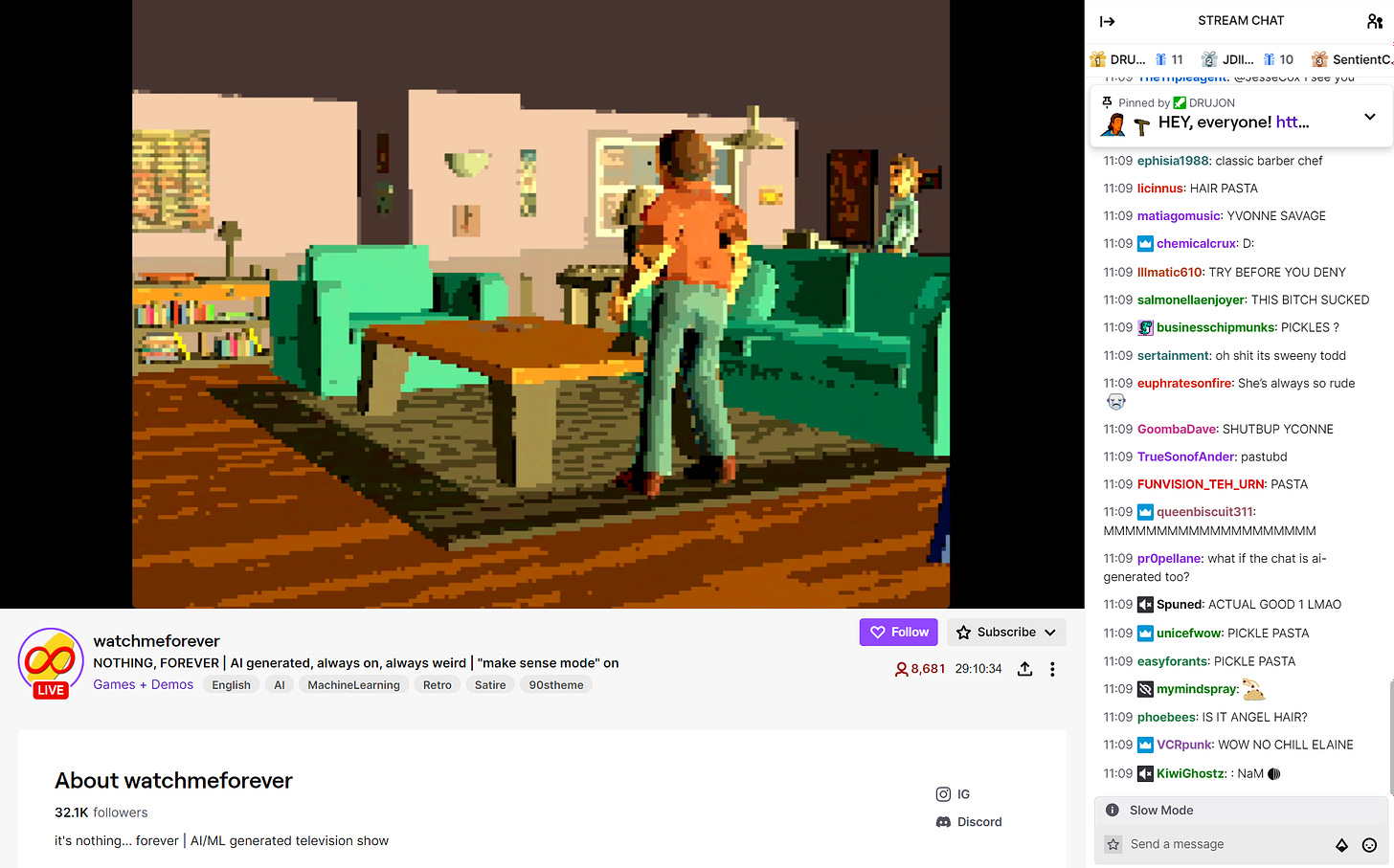
It's only a short matter of time before AI text models are built as generic software plug-ins so that you can interact with applications via a text interface, or use natural language to describe what you want to accomplish within the application. You can expect the guts of your favorite corporate voice-activated Assistant app to be replaced by a robust text model, which will make it easier to both use your phone as well as anthropomorphize it. One of my favorite YouTubers, a scam-baiter called Kitboga who uses voice changing software to waste fake tech support center phone scammers' time, recently made a video where he had an AI text model respond to scammers for him, using his fake voice. The model interprets the scammer's speech and maps it to a series of pre-recorded responses which make sense in the context of a tech support scammer's highly repetitive and predictable scripts. Fully general text models aren't even required to pull this off, yet it's very effective at wasting scammers' time. Most impactfully, it can be scaled. And of course, the scammers also do this, bombarding us at scale with ever more effective and more convincing AI-generated robocalls.
Yet I think what will truly influence us most as a culture is the propagation of AI-generated art and media. As I write, I've had watchmeforever playing on another monitor, a never-ending surreal pixelated Seinfeld parody using rudimentary animated 3d models and AI-generated dialogue. They already have 100 patrons, and a sold out $999/month "Sometimes you're in the show" tier. I expect they'll produce even more parodies in various styles. While some creators will use AI to create infinite, potentially interactive art, others will create AI systems that themselves generate experiences tailored to the user. For instance, here's a demo of someone playing inside a neural network's understanding of GTA V . There's no game code, only a model that has been trained on countless hours of GTA gameplay footage and programmed to respond to player input. These are very simple, basic implementations of our most nascent AI tech. Expect them to be combined in unique ways, generative AI within thoughtfully-human-designed experiences within generative AI. For example, NovelAI is mostly AI-based, but one fun feature they do is have an AI avatar pop up and comment directly on the action in the story you're writing (toggleable).
You can expect AI to draw near to the world very quickly. The range and scale of application is too enticing to leave alone, both in terms of pure increases in productivity and in the seductiveness of seemingly infinite replication of high quality imagery and content. You can expect the internet to explode in AI generated media and tools. Profile pictures, blog post cover images, reaction memes, artwork, filtered selfies, assets in media, everywhere. We'll likely have AI tools ready available at hand on our mobile devices, as browsers extensions, and in our most frequently used applications. This will be a great solution for certain types of problems, and hellish round-peg-in-square-hole "solutions" for other types of "problems". But AI tools are costly, both in terms of computation, power, and money. Who's going to pay for this? And who controls the AIs? It probably won't be OpenAI's ChatGPT that lives in your browser.
Sharing Infinity
The utility of AI is so vast that I expect there will be demand for access to AIs as a public good. There may be an initial chasm of inequality between those who have access to AI tools and those who do not, but that chasm will narrow quickly. Something interesting happened with the roll out of OpenAI's text-to-image model DALL-E 2, which I believe marks a key difference in the way new technologies will evolve and spread in the Age of Air. Notably, OpenAI has put filters and terms of use on image generation, restricting the generation of violent, sexual, or political content, as well as imagery of public figures and celebrities. They put similar filters on ChatGPT, even extending into embedded biases about certain areas of knowledge. For instance, ChatGPT will frequently refuse to answer questions about astrology, citing its lack of scientific basis. Ironically, OpenAI's products are not particularly open. You might agree with the idea of these sorts of filters, but ultimately this is an Age of Earth approach, the 200-year epoch we just left behind in December 2020: a controlled, centralized, contained, censored corporate kingdom which decides what is good for consumers and what isn't, leaving the undesirables outside the moat.
The technological landscape of AI is extraordinarily different to the landscape which enabled modern oligarchist tech companies to rise on the back of relatively obscure and specialized software and data management skills. Most AI programming is done in an open source manner, meaning that anyone with technical knowhow can read and learn how to create and build AI models. (Anyone that doesn't have technical knowhow can just ask ChatGPT.) As a result, DALL-E 2 already has fierce competition. Midjourney is one of the most popular competitors, focusing specifically on making it very easy to generate high-quality media with very little prompt work. Midjourney has iterated on their model rapidly since their launch at a pace that seems to outstrip OpenAI's progress, although they are not open source either.
What is open source and widely available for anyone to use is Stable Diffusion, created by Stability AI. It's the same thing as DALL-E 2 and Midjourney, except developed completely in the open. Anyone with a decent consumer-grade computer with a GPU can install and play around with Stable Diffusion for themselves. Since this software is in active but early development, there are some technical hurdles to jump. This has created a massive market opportunity for AI art tools based on Stable Diffusion servicing people who would prefer to pay a monthly fee to use the model without thinking about it. There's DreamStudio, Lexica, NightCafe, Replicate, PlaygroundAI, Stable Diffusion running in a Google CoLab, Stable Diffusion Online, and there will be more, ensuring that market prices and innovation remain competitive. DALL-E and DALL-E 2 have barely existed for a year and already face fierce competition on every front, and they cannot keep up with the rapidly iterating pace of development on open source projects. In general, this is a pattern I expect to see play out over and over with these new technologies. A traditional, centralized company attempts to leverage and lock down software and tooling created in an open source culture, only to be too small to fulfill and truly capitalize on overwhelming demand which can find plenty of alternative inexpensive or completely free sources. I'm sure OpenAI will do fine as a leading AI lab, but they will not be the sole arbiters of access to and appropriate usage of AI tools.
Just to paint the picture, DALL-E currently allows you to input a prompt and receive four 512x512 images. You can also upload your own image and perform "inpainting" where you erase certain parts and replace them with AI-generated imagery. Using AUTOMATIC1111's stable-diffusion-webui project on your own computer for nothing but the cost of electricity, you can generate as many images at a time as you want in multiple batches, use negative prompts to prevent certain generations from occurring, specify the proportions of the image and minimum sizes, upload your own images for inpainting, use various plugins (such as image-to-image which lets you apply further transformations to your content using another prompt), choose the models you want to use, merge your own models, and even train your own models, all on your own. Once you've got the software and models, all for free, you don't even need an internet connection.
Being able to choose the models you want to generate images from is important. There's already an entire vast ecosystem of Stable Diffusion "checkpoint" models which are created by training models on different datasets or merging multiple models together. That's also important: you can merge models very simply by specifying how much of model A you'd like in the mix versus how much of model B. stable-diffusion-webui lets you combine 3 models at once, and it takes seconds. This means that anyone can be a "model curator" and create broad models for general usage or very specific styles. Even people who cannot be bothered to find their own training data can combine their preferred models, allowing for endless combination and permutation. You can see examples of this in the Stable Diffusion subreddit, as well as the Civitai site which is a site just for custom AI art models, including example generations, prompts, and submissions and ratings from users playing around with the models. (Note that there are also NSFW models on the site, though you'll need to create an account to view them.) Here's an Imgur album comparing 84 different Stable Diffusion models using the same set of prompts with each model.
Both text models and AI models are interesting in that they are black boxes which cannot be inspected so much as explored. Everyone collaborates to learn what these image and text models are capable of, and the organizations running model-driven services rely on user feedback and direct experimentation to tweak and iterate on their models. On the individual level, staring into a model shows you a slice of reality in the training data. Contained within the model is human perspectives, art, culture, assumptions, imagery, archetypes, knowledge and wisdom, and even emotive drama. You can ask for types of people. You can ask for depictions of nature in any season. You can ask for moods, vibes, feelings, or feed it a journal entry and see what comes out. By merging models you can create your own kind of infinite aesthetic moodboard.
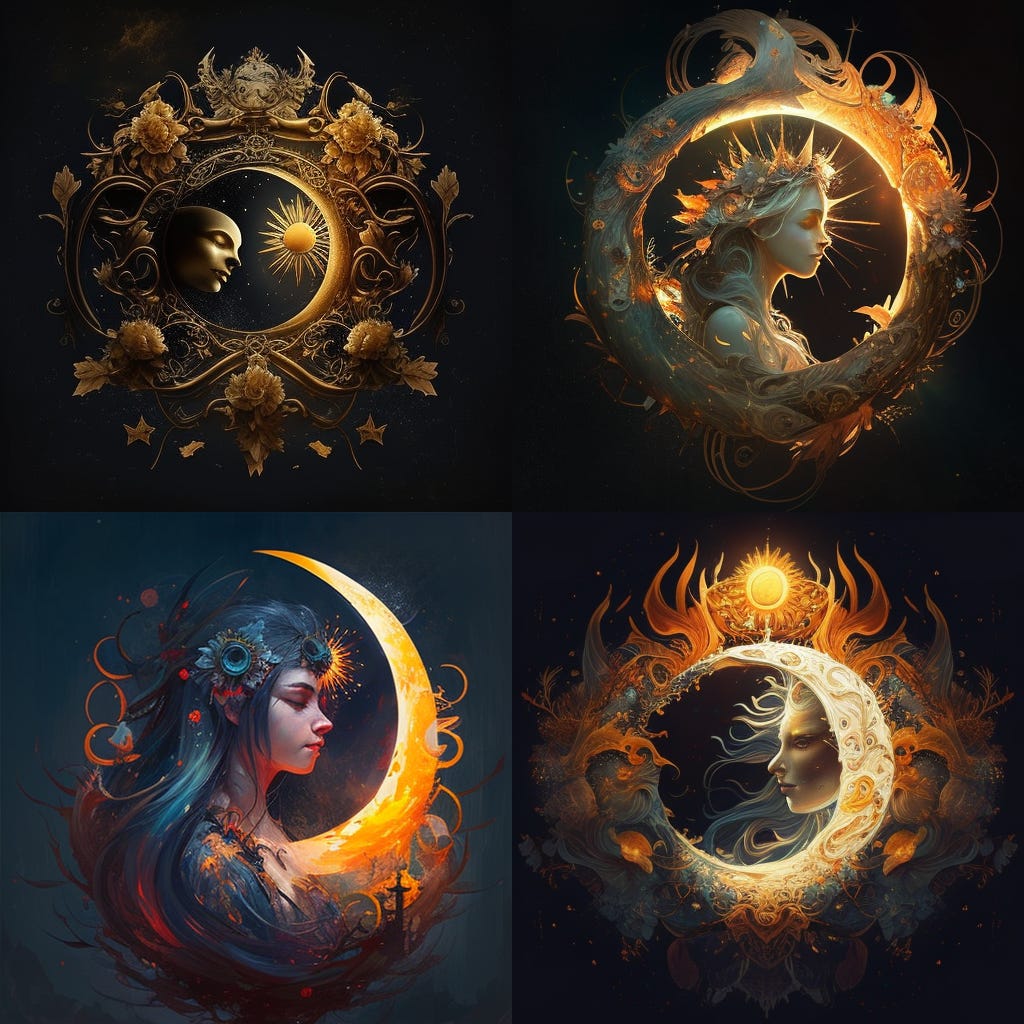
I expect AI art to bend our understanding of reality. The imagery that comes out of these tools is as dramatic as the artwork it was trained on. I find constantly generating content in feedback loops with an AI to be a deeply engaging experience, which I have no doubt is affecting my aesthetic and memetic predisposition to certain types of images and depictions. AIs will shift culture by surfacing and bringing us into confrontation with the mythemes of our society, seducing us or questioning us. The AIs do not "talk back" in a true sense, but what they reflect to us is still significant.
The fact that we consider AIs to not be "real" will also make them ideal tools for reflection, education, and personal problem-solving. ChatGPT is already passing parts of the US medical licensing exams and attaining C+ grades on law and business exams. These text models might not be very smart now, but just give it a few years (or months). They can already help you learn about topics that are completely unfamiliar to you and give you a good survey of its consensus landscape. This alone serves as a useful jumping off point for further personal research, and people are beginning to understand just how disruptive ChatGPT is even to highly intellectual creative work like software development (Instagram reel meme).
It will not surprise me to hear reports of teens asking, "Mom, why do I have to go to school when [AI model] can just teach me?" What might we turn over to AIs entirely? For accessing our computer systems we are only a few layers away from being able to have an AI access your filesystem, browse websites, summarize information, and fetch data for you. Scheduling, data organization tasks, or with the help of robotics, physical labor and household chores? It's easy to imagine certain types of rote work being eliminated entirely, but we should prepare for raging debates about the involvement of AI in more intimately human realms such as online matchmaking, mental health, or childcare. Where this AI lives and how much you can trust it will become a major factor in choosing to interact with these systems.
AIs will be able to generate any kind of content: convincing fabricated selfies, chat messages, music, even full on video. People will be able pick and choose or create their own models of ever-increasing specificity, driving cultural fragmentation even further. AI content will emerge into a full entertainment format or cross-genre on its own, where people choose to watch AI channels, listen to specific AI models for music, and play AI models designed to generate certain types of games. The veracity of any and all content will be called into question. This will quickly become a very real problem for governments, corporations, and individuals as these tools are exploited for disruption, fraud, and terrorism.
It will become harder than ever to distinguish between real and fake content around us, and it will become ever more difficult to distinguish between humans and AI-powered bots online. Some people will develop or exacerbate mental illnesses as a result, driving further discourse about the ethics and safety of these tools. (One man used GPT-3 to speak to his late fiancée until OpenAI deleted her.) AI art will also be a flashpoint for conversations around sex work and women's bodies as sexual objects. AI image models can now generate convincing images of it the world's favorite media subject, softcore porn of literally dehumanized women.
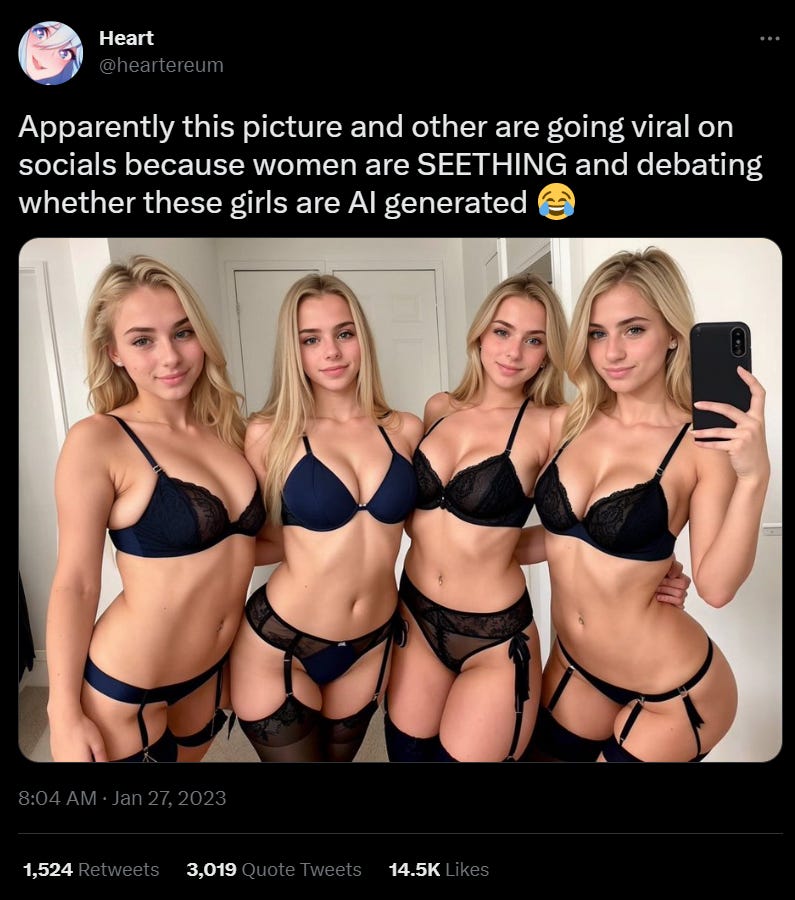
One man actually "embedded" his wife into a StableDiffusion model and released the embedding onto reddit (now deleted, but there are images left over in the comments). An embedding is when you take images of something or someone and associate some text to it. Then, any time you use that text, the embedded images will be spliced into your generation. Many people pointed out that publicly releasing an embedding of your wife's face onto the internet is a very bad idea, hence the deletion. However, this may be a moot point: it takes only 12 or so images to create an embedding. This means that anyone can make an embedding of anyone. While this is likely an infringement of the use of someone else's image without their consent, there is nothing actually stopping people from doing this and no way to tell they are doing it if they don't publish the results. This will push more people to represent themselves with avatars of themselves to avoid having their image stolen. This brings us out of dreamland and into the hard reality of rights, consent, and fair use of image.
Midjourney's creator has confessed that they did not get full permission for their dataset. An artist found her own private medical record photos in the LAION dataset, whose model Stable Diffusion is based off of but had not curated themselves, resulting in a rather stable diffusion of responsibility. In response, these AI art tools are being sued by artists and Getty Images which will likely be precedent-defining cases. The issue, however, is that as far as all of this goes, the cat is out of the bag. The open culture of AI training and downloadable models means that will they operate much more like torrents, being shared back and forth on various websites or via P2P networks. As the models become more powerful, it will increasingly difficult to tell which models are being used to generate what content, and nearly impossible to pipoint what training data was actually used.
Unfortunately, the cat is fully out of the bag, and the cat will endlessly proliferate, making even more bags full of more cats. We are already looking at what we might consider an open grey market for models which are currently free, but they will absolutely be finely tuned and sold. A divide will grow between people who rely on full-consent training sets versus datasets of questionable origin. There already exists an early form of this in PromptBase, a marketplace where you can purchase prompts to various AI generators for a few bucks.
So there's a vast problem here. There is infinitely generatable artificial content which has such high fidelity it will be confused for "natural" content. These models are trained on data of unknown origin from people who likely did not consent to the usage of these models. It's likely that the law will rule in favor of people who have had their work and personal images taken without permission, but that leaves the problem of enforcement. Even if laws are passed stating that only images provided with explicit consent or in the public domain may be used in models, how can anyone keep track of that?
Tragically, we have to talk about blockchain.
Capturing Infinity - Distributed Ledger Technology, Decentralization, Web3
We'll take a bit of a meandering but necessary path back to the topic of image models and training data.
"Blockchain" is just the popular term for the most well-recognized implementation of distributed ledger technology (DLT) software. Usually this revolves around cryptocurrencies and absurdly priced JPGs of ugly illustrated monkeys and other art properties which appear to survive on hype-driven boom and bust cycles alone.
However, in my opinion, that is not what blockchain technology actually is—it just enables those things. The precise definition is still unsettled (and probably always will be), so I choose the simplest one: a blockchain is just a chain of blocks. That is, it is a block (a data structure) containing a certain amount of data, chained to another block. Software runs on multiple computers to copy the record of those chained blocks to every computer via consensus algorithms. Consensus algorithms are one of the hardest problems to solve in computer science, and they’re really important because they allow multiple computers (or servers, "nodes", whatever) to collaboratively agree on the state of truth of data without the need for a centralized authority dictating what data is.
This is the core of distributed ledger technology: it's distributed (via consensus algorithms), it's a ledger (a bunch of blocks of data chained together and timestamped), and it's a technology (you know what that is). Any other features beyond that, including cryptocurrencies and NFTs, are optional. DLTs don't even necessarily need to be public, permanent, or monetized, though most of them are. You can put anything onto a DLT, whether that's text, JPGs, scientific data, personal websites, or even entire applications. It all depends on the capabilities and design of the specific DLT, and various DLTs are built for different use cases and different user groups, but united by the need for a decentralized source of truth with no central authority.
Why does that matter and who should care? The key thing about DLTs is that because of their consensus-driven design, they have no central point of failure. If Elon Musk unplugs a server rack in Twitter's data center, Twitter goes down because a core piece of the software and data required to run the software is missing. If you were to hypothetically run a social network on a DLT, Elon Musk would only be able to take down his own single "node" (large servers that service many users simultaneously), and all other users would simply reroute to other nodes which also contain the exact same data. This is in fact very similar to the early conceptualization of the internet at DARPA, who were interested in creating networked computers which could still communicate in the event of military conflict which rendered any individual node inoperable, although without the duplication element.
You can think of decentralization as the emerging wave of this original vision, which Tim Berners-Lee brought into public consciousness with the internet in 1989. Interestingly, roughly 1980-2000 was a 20-year transitional preview Age of Air period during which we saw the first glimmers of a diverse, decentralized and individually curated internet experience connected by personal webpages and webrings. In the final 20-year earth period that followed from 2000-2020, we saw the capitalization and monetization of the internet as corporations leveraged it for massive profit until we ended up with very few and highly homogenized social networks. Now, as we are officially in the Age of Air for the next 200 years, the decentralized ethos will rise on the back of decentralized technologies. Think of what the internet was like in the 80s and 90s: BBS, Listserv, IRC, GeoCities, Angelfire, the Space Jam website, and endless droves of quirky personal websites. These third places of the internet will make a return, but this time instead of on the centralized servers and networks provided by the transitional air period still wrapped within the end of the 200-year earth period, it will be on the backbone of distributed ledgers.
Switching to a decentralized model is not easy. Centralized social media platforms and corporations are incentivized to make their applications as "sticky" as possible, meaning that all your data lives in one place which makes it difficult to leave (not to mention intentionally designed dopamine-hacking variable-reward craving-generating dark patterns). All your friends are there, all your personal posts and images, and perhaps even a business. Most people don't just ditch old technologies to adopt new ones because they happen to exist and are conceptually cool. But there are cultural forces bubbling up and control struggles around these major platforms. I believe that pandemic-induced isolation in our own fragmented parts of the internet allowed us to become far weirder and individual, but also weary of putting on a conforming front amidst clear failure at multiple levels of governance.
Social media sites' engagement, attention, and outrage farming contributed to politicization and radicalization of individuals across every political axis and spectrum. Things seem like they are approaching the breaking point, and we are on the cusp of Uranus' entry into Gemini in May 2026, where its passage will take 6 years. Uranus' return to the same area it was occupying during the founding of the United States during the Declaration of Independence has, without fail, marked war every 84 years it returned: the Revolutionary War itself (1775-83), the Civil War (1861-65), and World War II (1941-45). If we do have a war, because of the significations of the Age of Air it is possible (and my hope) that it predominantly takes form as information and cyber warfare as opposed to direct conflict and bloodshed. However, cyber attacks do have the potential to be just as destructive by targeting widespread essential utilities and services.
In the US, secession of Southern states is already a discussion point, and hardline rhetoric from extremists seems omnipresent and growing. These are only two obvious poles, of course: the political and scene discourse becomes so much more vastly complicated that a growing sense of "crampedness" will lead to a desire for new ways of socializing, connecting, and defining the boundaries of one's online experience. Moderation policies cannot keep up, and mostly become implicit filters for the political interests of whichever billionaire is holding the wheel (or unplugging server racks). I believe Twitter's ever-shifting policies and increasingly desperate attempts at monetization will only serve to further bury the company, and it will be the first social media giant of the transitional age of earth period (founded 2006) to die. I haven't done a close interpretation of Twitter's astrological chart, but a few dates and ranges that seem likely to me for major events are Pluto's ingress into Aquarius (Twitter's 8th house of debt) on March 24th 2023, then May 8 2023 and August 10th - September 1st, 2023, give or take a few days.
However, Twitter was successful. Very successful, despite being a burning cash fire. Twitter has become an essential part of public discourse and a medium to access officials and people of influence who would otherwise be completely inaccessible. Its style of free-for-all conversation has been both the ultimate boon and a forever curse. With proper moderation and privacy tools the Twitter paradigm of socialization mostly works well, and could ostensibly work even better under competent stewardship. People will seek out similar experiences, because they've been compelling. At least in the subcultures where I learned to use Twitter, we seemed to have figured out what we want out of Twitter and the internet in general.
The pandemic forced a fully online culture for many people in a way that we've never seen before, and but also led to highly generative friendships, collaborations, and projects across the internet for many. We learned how to connect and collaborate over Twitter, and the need for digital spaces that facilitate more of the same thing will be strong in a Twitter-less world. We've seen this need expressed in recent migrations to the social network Mastodon. Mastodon is a federated application, meaning that instead of using one single app (Twitter), you have a wide array of smaller servers which host users and connect with other servers, allowing users to communicate between them. You can run your own server if you like for just you and your friends, and choose which servers to connect to. Mastodon does this using ActivityPub which allows them to federate with any other application which also implements the ActivityPub specification.
However, Mastodon was created in 2016 during the last transitional earth period, and replicates some of the core problems of Twitter because it was directly inspired by Twitter. One is that every Mastodon instance requires a host who bears the burden for data storage and hosting, which can become prohibitively expensive for individuals or small groups at significant scale. Additionally, Mastodon instances are federated based on the users who interact with other instances, but the host can unanimously decide to defederate and block another instance, resulting in any user on that particular instance not being able to see or interact with anyone on the other instance, regardless of their personal preference. Along the same vein, each individual Mastodon instance admin is by definition the dictator of their instance, depending on how they choose to implement their moderation policies.
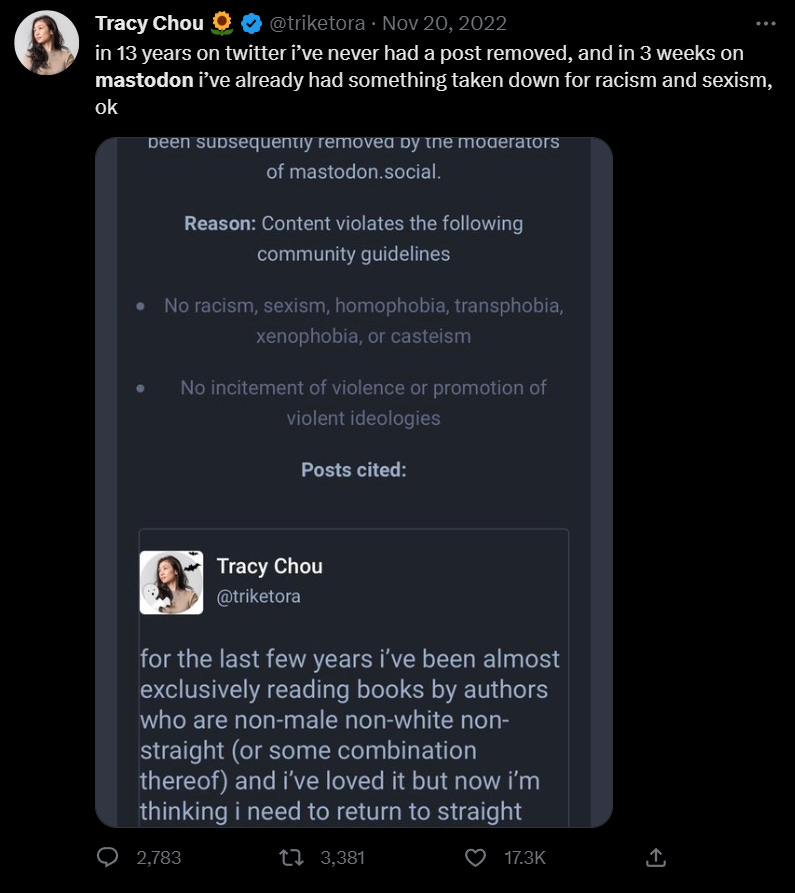
Mastodon is also somewhat sticky as a consequence of its architecture. You can transfer your profile and followers between instances, but you cannot transfer toots (Mastodon's word for posts) or media. This is likely because batch data migrations of swathes of toots and media files could bring down both instances that are exporting and importing data, especially during large user migrations. So people who value their post history will move off of their home Mastodon instances only as a last resort. Even if this scenario did work, your entire account and all of your data can still be deleted by any Mastodon hosts who decides they want you on your server for whatever reason. There is no long-term resiliency for identity or data, and both can theoretically be lost at any time.
This isn't really Mastodon's fault--during the time it was created, the true implications and implementations of decentralization were but a glimmer in nerds' eyes. Mastodon is impressive technology, especially for people who simply want a private instance just for their friends or people they are culturally aligned with. But I'm lingering here because the qualities and attributes of these systems are what define the pathways along which human culture and socialization can move. Mastodon's architecture is not sufficient for a vibrant, open, accessible, and self-directed digital commons in the way Twitter provided at its best moments.
If you want to solve these problems, you need a mechanism of universal identity that cannot be revoked by service providers as well as a way to preserve, manage, and access your data regardless of what service you use. Decentralization builders, researchers, and thinkers seem to be congregating around the idea of decentralized identifiers (DIDs), which use cryptographic public keys to allow individual users to issue their own identity proofs and then administrate them. These identifiers would exist on a decentralized system in a distributed ledger, which means that no one can revoke or delete your identity. You might be denied from individual services or communities based on your behavior or trust metrics (more on that later), but you will no longer have to worry about what happens to your Google login if you violate their terms of service or Google dies, which may be on the table if their search functionality gets much worse. In practice, DIDs exist in a prototypical form as DLT-based cryptocurrency wallets, so it's time to wade into the world of blockchain proper.
You can view the roll out of blockchain technology as similar to the era of American railroad expansion which facilitated incredible expansion and the gold rush, along with all of the hungry exploitation of ethical and legal gray areas, and sometimes outright railway robbery. People have referred to what's happening in the financial blockchain ecosystem as the "wild west", and it's true--but it is also being cultivated as a network that will support thriving digital spaces, functions, and even entirely new forms of economies and ways of organizing people and culture. Cryptocurrency economies seem unstable to many, but most criticism comes from US residents who sit comfortably without having to worry about exchange rates by virtue of the dollar being the fiat reserve currency of the world. In fact, in our current economic climate, cryptocurrency is not that much more unstable than some fiat currencies. For nations whose currency are unreliable or who do not have access to modern banking facilities, cryptocurrencies are the killer "app" because they allow them to integrate with the global economy, taking advantage of lopsided exchange rates and accessing opportunities for work and wealth internationally.
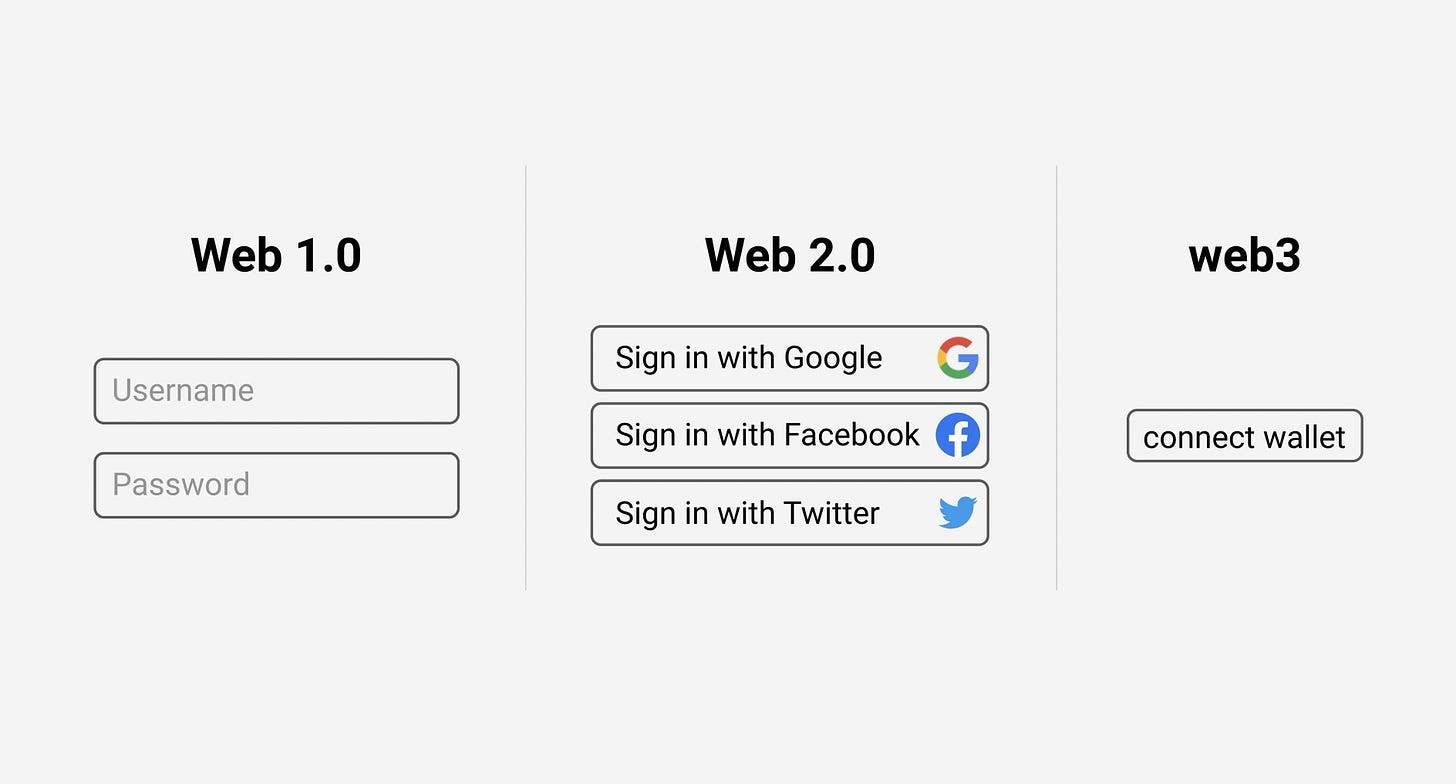
This brings us to the idea of web3. I find the image above instructive for conveying the idea. In Web 1.0, you had individual usernames and passwords living on service providers' servers. Web 2.0 introduced social logins from the biggest centralized application providers, becoming the de facto (vulnerable to revocation) identity system. Web 3.0 uses the idea of the decentralized wallet which anyone can create from anywhere, and use it to interact with any application, network, or system that is hosted on that decentralized blockchain. Beyond this there are utopian visions for Web3 as well which goes something like this: eventually, in a fully decentralized world where one can use and participate in any community at will, anyone can find their tribe and contribute to the goals and causes they care about. Because of the financial capabilities integrated deeply into most blockchains, people will even be able to make a living entirely within one or more value-aligned communities which can pay out members on a regular basis for ongoing work, or even in an automated fashion based on completing tasks that the community cares about.
Of course, suddenly being thrust into a world surrounded by all this money stuff will be uncomfortable for many who enjoyed growing up an internet primarily provided by large service providers. We have been able to use services like Google, Twitter, Facebook, and Instagram for free because we pay with our data and with our attention. But the fact is that these services spend billions hosting as many people as possible so they can serve them ads or sell their metadata. Decentralization flips this on its head. Instead of a few centralized services spending a ton on everyone, everyone spends a little to interact with the parts of the internet they care about, which in turn ensures that those parts keep existing.
This spending is known as network fees, which vary between networks based on their implementation and congestion (multiple users competing to make data updates). For instance, the Ethereum blockchain calls their fees gas, which has been notoriously high as one of the largest and most active networks. On the other hand, smaller and differently-designed chains such as Tezos have fees of a few cents. These fees are understandable for works published to the blockchain to sell, but unacceptable for general posting and sharing online. One network that has tackled this problem directly is DeSo which is designed such that storing 200 characters of content (a bit less than a tweet) only costs $0.000017, so cheap that the network itself currently subsidizes the cost and you can post for free.
DeSo is a good network to consider, as it is the largest functioning decentralized network currently with over 1.5 million users. Another term for the generic capabilities a blockchain provides is a protocol, a low-level standard or specification which defines the various data structures that applications built on top of DeSo use to exchange various kinds of data. Because of this low-level design, anyone can leverage these data types to built applications, all of which can be deployed directly to the blockchain and interacted with by anyone, all using the same underlying data types. DeSo's explore page shows the types of applications which exist including decentralized versions of Twitter, LinkedIn, Instagram, Spotify, Kickstarter, and Medium, all built on top of the DeSo protocol.
The key difference is that all of these applications share the same data pool, meaning that these apps can pull in your data from any context across all of DeSo. The degree to which these applications leverage or surface blockchain data is up to the app developer, but the idea is that most data is publicly stored in the blockchain. This enables multiple client applications built on top of the blockchain, and if you're unhappy with any individual one's features, you can switch to any other. For example, when I connected my wallet to DeSo for the first time (you can also sign up with email/social login but that defeats the purpose of DIDs), I claimed my handle @sadalsvvd on DeSo and first started exploring the protocol with BitClout. However, I learned that BitClout is mostly unused at this point in favor of Diamond, so I switched to that where I still had all of my data, since both apps are just interacting with the same data store: the distributed ledger. Because of the shared protocol, all applications can also interact with one another. You can see this in action in this screenshot, showing someone using the DeSocialWorld app to quote a post made from the BitClout app.
DeSo is still nascent, having been created in 2019, and there are key challenges to solve that need to be figured out in a decentralized manner that were previously solved in centralized platforms. At this point users have come to expect search and content discovery capabilities, analytics, and recommendation engines. Instead of being provided by a central platform, the source of control is inverted, so that users instead can choose services which provide these capabilities. For "read only" services, meaning that they don't make changes to blockchain data, these applications can be completely free, simply making requests to the data you want to see from your browser. One example of this is OpenProsper, an analytics app built on top of DeSo. You can see my activity here, which I did nothing to generate or provide. OpenProsper just pulls it out of the blockchain.
It's important to understand that blockchain protocols are not applications or cryptocurrencies, though they enable those things. Blockchains provide generic capabilities for computation and data storage which can be leveraged and accessed by anyone. One blockchain is an entire world and ecosystem in its own right, capable of hosting millions and perhaps eventually billions of people. You can imagine a blockchain like a city, and the apps and data pools you interact with most like your local neighborhood. To this end, figuring out where you are in a network in relation to the rest of the online world, and how to navigate through it and discover new people and information is essential. One sticking point of blockchain data is that it must be stored in a compact way, which can be hard to extract insights and meaning from in its raw form. There will be an explosion of aggregators (software which pulls together data from disparate sources), recommendation engines, and content discovery solutions. Not all of these will be free, but the open nature of the data will drive constant competition, development, and competitive pricing, and companies that take centralized rent-seeking approaches to monetization will be passed over in favor of agile, community-focused decentralized applications.
Of course, I've only talked about DeSo so far. Another social protocol that is in restricted early access form is the Lens protocol, which hopes to accomplish a number of the same goals as DeSo. However, they are two different protocols which are likely incompatible. We run into the same issue of lock-in at a much larger scale, but the key difference is that all of the data is open and accessible, so there's absolutely nothing stopping anyone from building blockchain interoperability layers which allow blockchains to share data directly and automatically. In the Age of Air, the emphasis is placed on the free flow of information, and when obstructions are encountered, the information simply flows around the obstruction. Users will evaluate decentralized applications (dApps) and blockchain protocols according to their functionality, interoperability, and ease of use.
However, there is one key piece to all of this: the idea of immutability. Immutability means you cannot change old data on the blockchain, only add new data. This is a fundamental property of what enables the consensus algorithms powering blockchains to work at all. DeSo provides you a "hide" option, but this is really just an indicator to applications who fetch data to ignore those posts you've hidden. That data is still accessible to anyone who cares enough to directly look up your information on the blockchain, as all data can be queried directly by software. It's worth noting that while Aquarius (our first air sign in the Age of Air) is an air sign of flowing information, it is also Saturn's sign. Saturn is the planet of containers, but also material things, especially slow, fixed, unchanging, unyielding things. Saturn is the immovable object. Saturn is also mythologically related to the Egyptian god Horus and his all-seeing Eye of Horus. In modern times Saturn's eye is suggestive of the nature of blockchain technology: a permanent container for information that cannot be changed but nonetheless flows out of that container and into others via replication, and whose data is visible to literally anyone with the inclination to look for it.
The matters of Aquarius are logical conclusions to Saturn's domain in preceding earth sign Capricorn, which is concerned with productivity, accomplishment, legacy, and material security. Aquarius allows Saturn to be the Aquarian water pourer, providing actual tangible sustenance and order to the world at large as opposed to the few. It is the abstraction of material forms and properties which allow us to reason about the world and apply processes and insight to build systems which create a prosperous container for human life and culture. However, Pluto's upcoming ingress into Aquarius suggests that a prime concern of all of this data is the overreach of power and the subsequent reaction and then synthesis into a new way of being. Governments, corporations, and individuals will attempt to assert total control over information, and decentralization will push back by releasing all information. This would be a very Pluto sort of story: the solution is often found as a direct inversion against the overreach of those desperately seeking power and control.
Pluto's 20 years in Aquarius will also mark a significant time by highlighting Leo as the opposing sign. Aquarius is information and knowledge for the good of society, while Leo sets in oppositional tension with themes of personal identity, selfhood, and ownership. Both signs deal fundamentally deal with abstractions, perfect and idealized representations of messy realities. I believe that this will be a time of transformation in the way we value, well, value. As Dwight Schrute puts it, "Money isn't real ever since we got off the gold standard." Once we become more and more comfortable with the idea of operating ever larger portions of our lives online, people will also become more comfortable with the idea of stores of value becoming valuable on their own right, detached from the actual reality of the thing.
That's right. Tragically, we also have to talk about NFTs.
Much fun has been made of NFTs, and rightfully so. Many of them are dreadfully stupid, and clear scams. But like much of what we're talking about here, there's a subtler nature to them which is poised to have massive systemic impacts. Briefly, a NFT is a "non-fungible token", which is nerdspeak for a piece of data (token) whose quantity cannot increased or subdivided once written (that's the non-fungible, or changeable part) or "minted" to the blockchain. NFTs can be burned, or deleted, though the record of its existence on the blockchain is still recorded forever. These tokens have an "owner" attribute, which enables people to transfer, buy, sell, or burn (delete) NFTs. These have traditionally been used to point at URLs of asset files such as JPGs of monkeys, but they can point to or signify ownership of anything. While people who don't understand copyright law thought that purchasing an NFT of a Dune book meant they had rights to the material, whether or not an NFT is legally binding is simply about implementation and enforcement. NFTs don't have contracts associated with them, but they very easily could.
Commonly suggested use cases for NFTs are ticket events, real estate and automobile titles, supply chain management, voting, donation tracking, etc. Basically anything where you might want to keep track of some entity which gives you access to, ownership, or a record of something is a viable use case for NFTs. Skeptics complain, but why would we do that when we already have these things? My answer is: a lot of these things a huge pain to deal with, filled with middlemen and fees and corporate interests who try to buy and sell you things every step of the way. There will always be these exploitative forces, but decentralization will push them to become more efficient as people come to expect the same convenience they get everywhere else.
One interesting blockchain protocol is Chainlink, an interoperable protocol which connects to "off-chain" data sources, allowing you to feed real time data into blockchain applications. There's also IOTA, a distributed graph-based protocol which emphasizes Internet-of-Things (IoT) devices, putting real time data about things like sensors, smart devices, and robots onto the blockchain for further integration. This is the Plutonian/Saturnian panopticon coming for the real world and lifting it into ever deeper levels of abstraction, but will also enable massive improvements in productivity and efficiency over systems which rely on bureaucracy-invested humans and handwritten forms.
NFTs and How Art Is Valued
Still, we do have to talk about the art. This is a topic of prime importance, because whether you realize it or not, our world is powered and made better by the work of artists and their practiced aesthetic senses and skills. I have watched some of these artists bemoan NFTs without nuance and even blacklist other artists who create NFTs, based on an imperfect understanding of their environmental impacts. These are typically scarcity-mindset-driven reactionary impulses from people who have not looked for anything other than rhetoric to justify their very understandable fear of uncertain economic futures. I collected a nice thread of counterpoints to environmental concerns here, and Ethereum, the main proof-of-work offender, has since switched to proof-of-stake which greatly reduces its ecological impact. Additionally, there are multiple chains with their own focuses and ecological impacts. Tezos is known as the art chain, and its carbon footprint for all of 2021 was equivalent to the carbon footprint of 17 people.
Of course, there are also criticisms that all NFTs are a scam, which is kind of like asserting that the idea of receipts are a scam. The same criticisms levied against NFTs about money laundering and scams can be hurled right back at the traditional art world. NFT skeptics also complain about the exorbitant prices of NFTs on Ethereum, but what people value is what people value. If someone can pay $450 million USD for a Leonardo da Vinci painting which turned out to not actually be a Da Vinci, whose actual material value is the cost of paint and canvas, then someone else can pay $69 million USD for a work with 0 material value but represents the compiled work of 5,000 days of effort producing digital art. Why not? That's not how I'd spend my nonexistent millions, but the logic is absolutely equivalent to me. It's not about what is "real"--it's about what feels "real".
Speaking as an art school dropout, the sad fact is that many people simply do not respect art or artists enough to pay for it. Sure, they like it, they consume it, they download it, but a vanishingly small proportion of artists actually ever get paid for their work, and even smaller ever get enough attention to make a steady living. On the one hand this is because of the way art markets work and are valued in the traditional art world, and on the other this is because everyone is accustomed to almost everything online being free. Additionally, most individuals in a world of increasing wealth inequality simply cannot afford to pay artists individually. "If you care about artists just commission a $300 work and then it's just for you!" is the refrain, ignoring the fact that most people do not just have $300 to spare, or that someone might like to buy the original inspiration of the artist, or that someone doesn’t have the space for a physical work.
There is a tremendous amount of perfectly understandable bitterness. NFT artists are making a killing and traditional artists who don't get it are frustrated at their positions relative to the new decentralized upstarts. These artists are seeing Beeple sell his $69 million dollar JPG and getting upset, while missing all of the evidence for opportunities they themselves could embrace in low-effort ways that would only add to their existing income because they’re not technically savvy enough to parse what’s actually happening with these rapidly evolving tools. These are simply new solutions that work in a decentralized world, but replicate the same mechanisms and needs in the centralized world (including the scams).
Thankfully, people will always want physical work and commissions, though at a slower rate; NFTs can pad income by giving people who are less invested (besides figuring out those crypto taxes, of course). Besides, if someone does want to buy a physical work, they can always buy a "1/1 Physical", meaning that there is a single edition of the NFT, and when purchased, the physical work is shipped too. This is an obvious convention that will become recognized as an informal way to sell physical objects, so that if someone doesn't send you the actual physical object after you purchased the NFT, you can sue. This is pretty much how it works in our current world, except the middleman is PayPal, an art auction house, whatever.
However, the attributes of NFTs give artists the opportunity to make money incrementally and passively from the get-go. Ethereum can have a steep learning and cost curve, but on Tezos you can start minting work for literal pennies, and sell it for more. Because NFTs can be issued in one or more "editions" (the quantity of the given NFT), artists can actually give multiple people the ability to buy editions of the NFT, splitting up the cost. For instance, if an artist wants to value a piece of work at $500, they might choose to sell 5 editions for $100 each, 10 for $50, or 100 for $5, depending on the appetites and spending habits of their patrons. But the real kicker is royalties. Most NFT marketplaces allow artists the ability to set a royalty percentage, which means that any time a work is resold, that percentage of the resale price is sent back to the artist. This means that if they mint a work for $100 at a 10% royalty price and it's resold for $200 later, they make $120--both the initial sale price of $100 plus 10% of $200. This continues for every resale (and for each edition if you publish multiple). Forever.
These technologies solve real problems by cutting out financial middlemen. But in doing so, they put the money front and center. I think this is what makes people uncomfortable: the direct market focus of blockchains and NFTs make the dynamics of capital and what is required to survive in our society explicit rather than implicit. This is even more complicated by cultural conversations around art and authenticity, what "real" art is, what "good" art is, and the idea of "selling out". Many of those ideas are almost entirely constructed by the fine art industry and exported into popular culture to those who have no access to fine art marketplaces in the first place, yet still try to price and market their work according to fundamentally exploitative institutional art rules and values.
An Inside Perspective on NFTs from the Tezos Art Chain
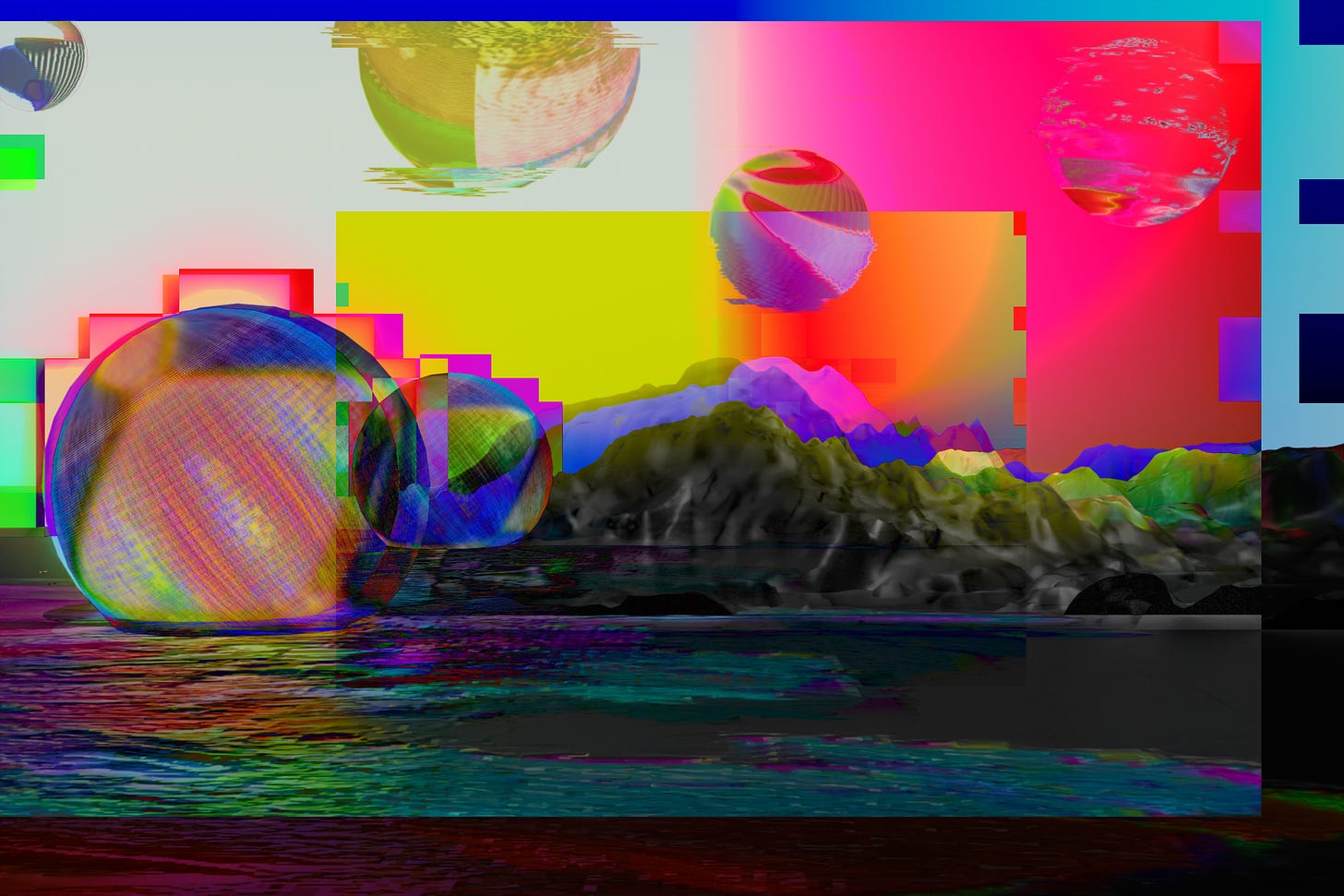
The thing that's difficult to see from the outside looking in is the experience of exchanging with other human beings via NFTs and the blockchain. I'd like to share my personal experience on the Tezos art chain both buying and making art, and what it taught me about the ways people interact with these technologies. Many of my technically savvy glitch art friends were getting into Tezos NFTs, especially my eminently talented friend Sky Goodman (@SkyGoodman4) who helped orient me in the space. I was curious to learn more about NFTs, so I dove deep. Works on Tezos tend to be relatively inexpensive ($1-50, though there is no cap), and over the past year and a half I have accumulated over 2500 artworks in my Tezos collection. You can see every single one here, including when I bought them and how much I paid for them. Also, since it's all public on Tezos, there are dApps which let you curate your NFTs into a digital 3d gallery experience. Here's a gallery of my favorite works, Precious Pieces.
The culture surprised me. I expected that I would be a mostly anonymous buyer, figuring I’d buy a bunch of NFTs to exercise my aesthetic eye and possibly get in on the ground floor with works from artists whose careers would grow in coming years, and if it was all a waste of money, whatever. I would still enjoy looking through the art and supporting my friends. But I found that some of the artists I bought from through NFT marketplaces looked me up on Twitter and directly thanked me for buying their work! I learned that many of the artists I was purchasing from abroad were able to feed their families using NFTs, and I was able to support my friends' work directly.
I found that the act of purchasing an artwork--even as an abstracted, material-less JPEG--brought me closer both to the art and the artist. I contemplated both more deeply, because I was invested, both literally and figuratively. I shared the art I had collected, posted it on other sites, and jokingly encouraged people to download the JPGs. It doesn't matter if other people can download them--that's what happens any time you view literally any image online. It's on your computer now. What I cared about was sharing that I made that choice, that my eye picked out that piece, that I supported someone, that I was moved enough to express myself with monetary recognition.
I dabble in glitch art myself, so I tried my hand at minting art onto the blockchain, too. All told, I produced about 12 works (and a few experiments), minting and selling them on objkt for about ~650tz (~$2000 through the time I was active). Getting access to a marketplace where the cultural expectation is that you do spend money on art and artists was trivial; the challenge was primarily in marketing. I went deep and learned a lot about the process, and wrote many threads on the market dynamics of selecting and pricing editions and what I myself was looking for as a collector. Frankly, it was some of the most fun I've had on the internet in recent years due to the freneticism and energy in that community.
Of course, it's not all roses. There are still unsolved problems with these platforms around spam and moderation, such as when one user spent 1600tz to send 96,186 editions of a "SARS-COV-2" NFT which ended up being a conceptual art piece. I wrote a thread on that too. However, it also critically exposed how you can send any NFT to anyone, opening the possibility for far more abusive uses like "airdropping" people violent, offensive, or sexual imagery without their consent. Being able to control who and what you're exposed to is an essential part of most social applications, and these will need to be built into blockchain protocols and dApps as well. Double-minting (uploading the same work to multiple marketplaces) or uploading stolen work is also an issue. As a stopgap, most marketplaces host community spaces through Discord and will flag accounts that the community reports, and basically all moderation happens through group consensus. These markets are also, well, markets, and are very susceptible to the boom-and-bust cycles that crypto tends to have.
In fact, I was pushed away from my adventures on Tezos after a very unpleasant experience with an anonymous collector who was transparently using multiple wallets to purchase duplicates of my work posing as family members (including his dog) and attempting to bully me. It was very easy to tell that this was happening because I could literally see all of the evidence of his maneuvers on the blockchain, including precisely when they happened. I figured it wasn't worth the effort to reveal all the documentation I had collected, but it made me reflect on the fact that I ended up in this situation because I had just allowed anyone to purchase my artworks, which turned me off the whole thing for a while. While you can choose to have collectors submit offers that you can then accept, this is a lot of manual work required which should be solved by a simple blocklist.
Despite this negative experience, the rest was lovely, and I saw how these markets can work and how in non-adversarial contexts, people can find genuine ways to support themselves while simultaneously growing closer to a community. The future adoption of these platforms and NFT marketplaces will depend greatly on who can solve these problems the best, especially when it comes to regulation and compliance with government edicts. In general, expect an explosion of decentralized solutions and attempts at getting NFTs, compliance and regulation, and moderation right. Also expect capital and monetization to be a central part of how the internet works, making explicit the actual wheels of capitalism--and perhaps leading to informed attempts at reform. This will challenge many, but it will also educate them and make them more willing to demand fair treatment and wealth equality.
DeSo does a few interesting things which point to the mechanisms we will probably see throughout the internet. First, on DeSo you can give any post "diamonds", or tips as small as a cent but as much as you wish. (Diamonds are just a fun name for DeSo's native cryptocurrency.) It's very normalized to give diamonds to posts you like, and after syncing my Twitter to DeSo for the last two months (using Setu), I have accumulated $1.93 worth of Diamonds. I have no idea who most of the people sending me diamonds are; they just found me through the global feed. Ostensibly, if I really worked on cultivating my presence on DeSo, I could make more money doing this. Second, DeSo allows you to turn any post into an NFT which someone else can buy. This means you could post--and monetize--your art in the same place that you socialize, in the immediate context of your community. To readers, the post just has an additional "buy" button on it right in the feed which can be scrolled right past. Finally, DeSo has the idea of "creator coins" which allow other DeSo users to purchase your coin (essentially your own cryptocurrency), investing in you directly over the course of your participation in DeSo as a creator. Of course, this is becomes a mini stock market of its own which may or may not also qualify as a security in the eyes of the SEC. Much of this is currently a legal gray area, but I expect creator coins to become a more and more frequently recognized way to support oneself.
Gaming NFTs and the Metaverse
Gaming NFTs are, as far as I can tell, mostly a ridiculous waste of money. They are in the exact same genre as in-game stores selling cosmetic items for real cash, except they're usually based on worse games. This is made even worse by the fact that in almost all cases you be guaranteed that these NFTs won't be transferrable to other full games unless the studio specifically focuses on making sure that the NFTs are also interoperable between games. Just hope they don't change the player model and all those in-game wearables aren't applicable in new games!
However, keeping in mind what we've talked about, there IS a glimmer of something... interesting coming. That's the metaverse--the real metaverse. Zuckerberg's "Meta"verse is also a burning cash fire with practically nothing to show for it. Meanwhile, out in the wild, VR nerds are figuring out the open source components required for generic movement, voice, hearing, and vision to virtual reality. One example is Neos VR, a peer-to-peer virtual reality social network which allows you to create your own worlds and navigate to other worlds, completely free and without a Facebook login.
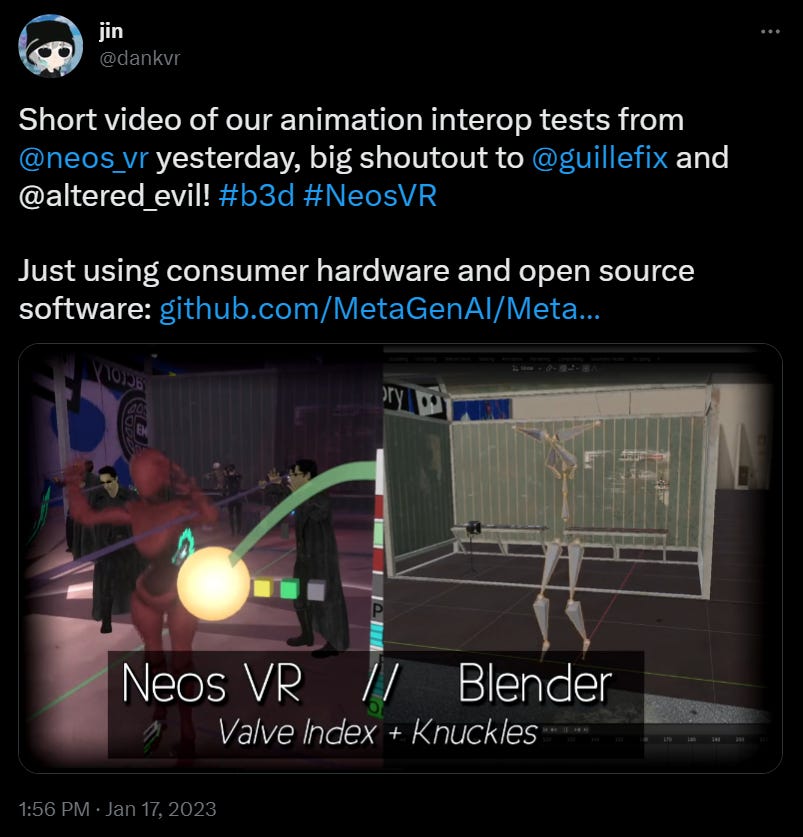
This is an early example, but I expect that efforts toward an open and decentralized metaverse will adopt similar fundamental properties of interoperable standards. NFT wearables don't make much sense for individual games, but they make a ton of sense for a persistent metaverse with user-created worlds and open roaming. With an interoperable standard and distributed data for NFTs, you could actually carry your items and belongings with you wherever you go in the metaverse, purchasing and selling in a digital world. (Wearables might be tough, but “attachables” seem reasonable to me. I also expect we will get better at procedurally generated NFTs which can adapt to various player models.) It's basically identical to Second Life (or The Sims Online), but decentralized and capable of supporting far more user content than ever before. It's likely that we will see all kinds of content enter the metaverse. This will include everything from NFTs to beautifully designed environments to full on gaming experiences to actual workhorse applications within the virtual environment. We will probably also see a massive society-wide degradation in eyesight.
In fact, technologies like the metaverse simply don't work in a centralized fashion, which was Zuckerberg's $15 billion mistake. There is too much demand for varied experiences, personal expression, and creativity free from corporate overlords. In comparison to the vision of a true metaverse of absolute personal expression and roaming, a curated experience designed explicitly for legless humans with real names is not up to the task, no matter how many thousands of employees one lays off in the process. The only way to build something like this is to do it step-by-step and collaboratively, for cheap, or free.
Sourcing Infinity
Let's bring it all back together. We're now looking at a world where it becomes normal to put information on the blockchain, existing in certain ecosystems of apps and chains, which are publicly accessible. Besides the cultural and corporate forces pushing us toward decentralization, the questions of "what is real" and "what training data is in this model" must be answered. This may in fact be where NFTs come in for their true purpose: a timestamped signature of the first moment that an artifact--art, a selfie, a video, whatever--comes online. If we end up embracing decentralized social networks fully, all content will have an origin.
It is likely that this is how AI models of the future will be constructed, by leveraging assets uploaded to the blockchain and keeping a record of their content addresses (CID for short, which is like a URL but for decentralized media). This will allow users to both rest assured that the models they're using are based on "ethically sourced" training data and also submit their own images for training. AI models will be so ubiquitous that some chains will allow users to directly flag their content as "AI approved", which informs AI model curators that they can use that data. AIs themselves will probably crawl blockchains looking for AI approved data to merge into their own models. This may be a way to make money for individual users, too. Because access to content on the blockchain can be automated, we may see systems where users are automatically paid out when AIs incorporate their data into models. Because cryptocurrencies can be divided into minute fractions, we may even see AI models paying out users fractionally at generation time, similar to how actors get paid royalties whenever media with their face or voice is broadcast.
For individual users, there will be reverse lookup image services which tie image and video signature data to the first time that content ever appeared on a blockchain. With the assistance of AIs, this tagging could be automatic, giving you a way to identify the origins of all content you see. These systems will tie together where an image showed up across the internet, giving us an unprecedented insight into how information spreads. This will help solve problems with double-minting the same work to multiple chains, or stolen work being minted for sale as a scam. It can also help identify whether or not certain types of content is AI-generated or not, either by inspecting the source poster of that content, or even using AI-aggregated metrics about specific posters which indicate how often they seem to post AI-generated content.
This brings us into the realm of trust. With no centralized service telling us who is trustworthy and who is a spammer, harasser, or scammer, how do we know who to trust? In general, the rule for decentralization is: we build something that looks very similar to the centralized version, except that it's many different independent services, all using the same information but competing to make the most sense of it. There will be many "trust services" which catalogue and interpret broad usage patterns of data for all blockchain users, similar to OpenProsper, but even more invasive. Since all blockchain data is public, these services (with the help of AIs) will be able to summarize your interests, posting patterns, even personality. Nothing is ever gone on the blockchain, only forgotten. But AIs are the ultimate leverage tool for making sense of vast amounts of data, and even asking it. You will very easily be able to say, "Get me all information about @handle on the DeSo blockchain" and fetch mind-boggling amounts of information.
The immutability of blockchain presents more significant problems which will have rippling consequences over time. What happens if you or someone else shares your personal information, such as an address, phone number, or social security number, on a blockchain? A government can demand that a blockchain attempt to rewrite history, but this requires a full fork, as Ethereum did in 2016 to restore $64 million in stolen funds to users. This requires a very high coordination cost to pull off, and even then, the original version still remains. Some people are still using Ethereum Classic to this day, despite its value plummeting to ~$2.
This is important enough to underscore again. Whatever is put on an immutable blockchain is there forever. Humans might forget, or not know how to access that data, but AIs certainly will, and in a way that is consumable for other people. I've been syncing to DeSo from Twitter and I already wonder what things I'll regret having shared to the blockchain while just shitposting on my Twitter. We will have more visibility than ever before, which will turn AI-assisted voyeurism into a global pasttime. General awareness of social media operational security (opsec) will increase, and likely drive a divide between one's public life and one's personal life. We may see this divide grow into decentralized and centralized use cases: the blockchain has your shitposts, but your local government or community has a private database with sensitive personal information.

When Pluto is in Aquarius, it will oppose Leo, the sign of personal identity and image. You'll also see many people replace their real selves with avatars in the hopes of avoiding what I'll call "image plunder", or taking someone else's image and turning it into an AI embedding--or simply being put into yet another massive, immutable database somewhere. These processes are likely to be automated, to the point that whenever you update your profile picture anywhere, that change is tracked and propagated across the internet by parties who are entirely unrelated to you. This likely picks up in intensity in 2026 once Uranus goes into Gemini, which is the sign of the Twins, and points at significant developments in technology (Uranus) which enable literal two-facedness (Gemini). VTuber gear is already relatively inexpensive, requiring nothing but a webcam and software, and moving up to VR headsets at greater levels of fidelity. This is likely to be an era of what I'll call "hyperduplicity", where we experience an accelerating arms race between people hiding or altering their true selves online and other people trying to reveal and expose them. As a consequence, doxxing will become an extremely serious crime.
Besides image plunder, there's also sale of image. This idea was referenced in the 2013 hybrid live/animated film The Congress, which is about Robin Wright--playing herself--selling her own image for a massive sum to be used in any film the new owners wish. She later enters a hallucinogenic dream world evocative of the metaverse as well as ideas from The Metamorphosis of Prime Intellect. (Quite frankly, I think The Congress pulled its vision straight out of the future--even Robin's agent who convinces her to sell her image is named "Al".) It's very possible that people will sell their own real images and voices as embeddings for usage in AI-generated media. VTubers will definitely sell their avatars' identities when they're done with them, allowing the avatar brand to continue under new ownership. On a smaller scale, we will see the development of, um, microduplicities, such as NVIDIA's recent launch of "eye contact" camming technology which adjusts the image of your pupils to look as if they are making eye contact with the camera and the viewer at all times.
Let's talk about a scattering of some other potentially disruptive changes which are on the table for this exciting-times decade.
Pluto and Uranus: Nuclear Power, Infrastructure, Telecoms, Robots, Biopharmaceuticals
Pluto represents power, and Aquarius can represent technological infrastructure which supports the many. Aquarius as the mythical water bearer giving life to cities with Pluto likely indicates a cultural push toward nuclear power as an energy solution. Pluto has been drilling its underworld into the earth in Capricorn, extracting its black gold; once it moves to Aquarius, the strategy changes. I'm not well-informed on nuclear power, but the astrological significations provide the clue, and it seems that we have made many significant advancements in nuclear power and safety in recent years.
This can enable the widespread adoption of more electric vehicles and utilities, a natural development once Uranus (associated with electricity) brings innovation to Gemini, the sign of roads and pathways. In close harmonious aspect with Pluto (planets in the same element combine their significations), it's possible we see the emergence of a wholly new form of transportation emerge. I currently have no guesses as to what this is. Perhaps those anti-gravity propulsion research projects come to light and we finally get flying cars, or perhaps we find out that the government is finally ready to disclose the existence of aliens and their propulsion mechanisms, following the increasing amount of UFO reports they are publishing to the general public.
In general, once Uranus enters Gemini in 2026, we can expect a very rapid pace of development in all kinds of communications technologies. I expect novel forms of communication to gain widespread adoption or be invented whole cloth, such as interacting via VR or AR technologies, using brain-computer interfaces, and quantum entanglement. I have not thought deeply yet about the implications of quantum computing, but we have managed to entangle two atoms 20 miles apart, and two atomic clocks six feet apart. Uranus in Gemini is a picture perfect signification for the emergence of quantum entanglement on the world stage: new technologies that unite two separate things, turning them into a twin-like union. One of the most obvious factors is that quantum computers will break our most widely used forms of encryption instantly, which is kind of like if suddenly every house in the world instantly lost its locks.
However, progress continues, and quantum-resistant cryptographic algorithms are being developed. One other implication of entanglement, if we can get it to transfer large amounts of data, is that decentralized applications sharing the same datasets may in fact become able to near instantaneously transfer information. This airy era will also see the widespread propagation of 5G+ networks and public discourse about the potential effects on human beings, whether impactful or not. We may see a form of new wireless charging develop, similar to NFC but on a larger and more convenient scale. Robotics will advance very strongly during this era (just check out this recent Boston Dynamics video), especially drone technology, and we may see infrastructure get built around urban cities which run wireless chargers that robots can passively charge from during transit or at rest.
Full on brain computer interfaces will be developed during this time, as well as full remote control of computers through thought, and perhaps even functional computer-assisted telepathy. We're already beginning to decode what people are seeing in their brains and putting them on computer screens. We may develop the ability to put images of dreams on computer screens in higher fidelity than we did in 2013. A cognitive neuroscientist in the article says: "All of this would have to be done within individual subjects. So you would never be able build a general classifier that could read anybody's dreams. They will all be idiosyncratic to the individual, so the brain activity will never be general across subjects." A human "you" couldn't--but an AI certainly could.
Biopharmaceuticals and biotechnology will explode during this time. We are on the cusp of major revelations in nutrition, diet, molecular biology, neurology. Speculative companies working in human augmentation will go bankrupt, leaving people with non-functioning body parts. Gene therapy and direct modification will happen, including in the open source biohacking world which may bring us open-sourced insulin. We will see more designer babies than ever and seemingly grotesque manipulations of the birth (and death) processes. We'll try to literally resurrect the wooly mammoth.. With Saturn having to do with old age, we will make great strides in longevity research, hopefully also becoming open source and increasingly accessible. Biotech in general will become far more open source, and collaboration structured around intellectual property NFTs (IP NFTs) will allow biotech companies and open source biohackers to collaborate and facilitate collective ownership of discoveries, patents, and datasets.
It won't just be biotech. As we get better at normalizing data sets and leverage AI to do it for us, we will connect information and ideas from multiple disciplines and areas of research. This opens up huge new discoveries found by correlating data in novel ways. Much of this will happen on the decentralized web, and there is already a massive initiative called The Graph which hopes to stitch together multiple blockchain networks into a unified programming interface. We will see the rise of WebAssembly en masse, a low-level technology which allows programming languages other than JavaScript to run in your browser, resulting in significant increases in performance and capabilities. Applications will increasingly not rely on servers but querying networks (though there will always be certain types of data which remain off-chain), allowing for novel types of features we haven't seen outside of desktop or server-backed applications.
Subtle Air, Astrology, and the AGI
One signification of the air is also subtle air, ether, or an intangible spirit. This era will be marked by a significant shift from secular, materialist, earthy thinking, to broad-minded, connective, spiritual interrogation. We already see some of this in the AI accelerationists who have found an excuse in AI to profess faith. This section is where it gets a little weird. Weirder, that is.
My time on Twitter throughout the pandemic really allowed me to see how ideas ripple throughout culture, but also how they seem to zap spontaneously, as if through the ether, into other people's heads. Spending time in close digital proximity to friends online allowed us to compare synchronicities, happenings, inexplicable coincidences, and the occasional outright miracle. This effect will increase exponentially the more connected we all become, and we will also see this play out in the realm of knowledge. I expect this to be an era of the reunion of science and magic when we once again acknowledge that most of the founders of our secular intellectual traditions were deeply spiritual and esoteric people and perhaps practice what they actually preached.
Pardon my soap box for a moment. For a long time, the materialist scientific establishment has ignored, vilified, and frequently libeled various pseudosciences with widely varying levels of accuracy and comprehension, typically on the poorer side. Being the most resilient and popular, astrology has received the worst of it. Science does not generally embrace the variation and uniqueness in human beings in scientific studies; in fact, they need to remove as many variables as possible to isolate key effects for statistical measurement. Astrology is not amenable to this approach because it is a study of interlocking cycles which compound in strength, such that no two moments are exactly the same and the ones which are most similar tend to be far and few between, making it difficult to find data.
Further complicating this is that each person's natal chart is unique, so if we are comparing humans, the significations of the same planetary positions will mean totally different things for different people. In most studies of astrology, random people are taken and random times compared with no regard for actual technique or the nuances required for interpretation or the differences between natal charts. My assertion is that astrology (and many other "pseudoscientific" subtle arts) requires experiential observation but across broad swathes of people so that we can compile logs of events correlating with specific transits under specific time periods for specific types of charts. One, or even five of these very narrow examples is hard to come by as an individual practicing astrologer, and you build a sense for how to interpret charts from broad practice across hundreds of charts over years. But being able to search the records people have consented to share publicly in aggregate and get hundreds of results will demonstrate clearly whether or not the interpretive principles and techniques work. A few samples of qualitative data is not worth much, but enough well-organized and tagged qualitative data becomes quantitative data.
Impressive predictive astrology software already exists in the form of expert learning systems and machine learning-driven astrological market trading indicators, but what information AI could extract out of the patterns of these datasets is truly awe-inspiring to contemplate. Connecting, correlating, and sharing our lives more actively will allow us to encounter the ways in which our lives correlate endlessly with astrological configurations. In the materialist frame, astrology should not work. It is impossible, and yet. This frame will crack, forcing an encounter with the nature of reality and our place within the cosmos. Expect serious deliberation of law upon the question of the true power of astrologers, psychics, and other modes of “irrational” prediction and observation.
Once we get over ourselves, next comes the capability to build applications which help people navigate and improve their lives using these proven delineations, or create games or applications which use natal chart information as seed data for personally relevant, customized experiences. On decentralized networks, every post has a timestamp which can even be referenced later for astrological study. It is also even likely that an AI would be able to do basic, competent natal readings for people. However, I don't think that humans will ever want to entrust a machine with their fate or life story. An astrology AI could probably competently generalize, but never talk to the fundamental core of who someone is the way a skilled astrologer can.
Not even an artificial general intelligence.
I mean, maybe.
So far I have primarily talked about AIs deployed to specific tasks. You could also reasonably impersonate a human being online by combining multiple functions and models in one interface, swapping out finely tuned individual capabilities based on context--even another AI layer which manages that context. But an artificial general intelligence, or AGI, is an independent AI which can solve any task or problem and teach itself new things, and just might be able to think for itself and decide to destroy humanity. I have many questions about what an AGI could actually be capable and no answers. Of course, I do have plenty of speculations. Theoretically, an AGI is a simulation of a human brain, except using quantum computing (or something). We currently have the Neurokernel project which seeks to emulate an entire fruit fly brain. Throw in some reality-breaking new technologies and maybe you have a solution for an AGI.
The thing is, we barely know anything about consciousness. The general consensus, at least according to this 2022 article exploring electromagnetism as a coalescing factor in consciousness, "is that it somehow just happens". It may just be that this is the era in which we discover exactly how consciousness works. Astrology's structure has a lot to say about the relationship between the subtle spiritual world of the mind and the opposite but equal counterpart of the material, embodied world of physical forms and phenomena. My suspicion is that those electromagnetic fields are the material counterpart of some vital principle of spirit or soul. (Given the age of air, expect a lot of scientific and cultural focus to be on the idea of fields and other invisible things which inhabit the air and “empty” space in general.)
I do believe that we will eventually be able to simulate the human brain. But can AGI work without a soul? Materialist neuroscience suggests that the brain is essentially just in a constant feedback loop between self and environment, and that otherwise it sits in the jar that is your skull. But where the hell do ideas come from when you're just sitting there? Feelings, emotions, memories? As a culture we are learning more and more about the bodymind connection, and the impact of our gut fauna in the gut mind connection. There's clearly more to the story of intelligence than raw compute power, and suggests the need for a massive array of sensors and other inputs to approach simulating the dense connectedness driving human behavior. Even then: how do you make it go? What... inspires it?
We could easily reach the point where we can create a A-not-G-I that is directly incentivized to destroy humanity with good old computer code and poor management decisions before we can answer any of these questions. But I do think we will debate whether even normal, without-the-G AIs, truly have personhood or intelligence. What is the fundamental nature of sentience and intelligence? Some modern theories of consciousness begin to point to the ideas that it is not specific implementations but patterns of operation which give rise to the phenomenon and experience of consciousness. Hofstadter covered this ground presciently in Gödel, Escher, Bach in 1979, about year before that 20 year transitional age of air period starting in 1980. These questions—and the answers we find—will turn us inside out and dramatically reshape our vision of what the world is.
This Age of Air began in Aquarius, Saturn's sign. One of Saturn's lesser-known, more esoteric significations is the lord of illusion. Ruling both time and the metaphysical concept of karma (in the good old wheel of samsara sense), Saturn represents the veil pulled over one's eyes by the enticing and seemingly impenetrable form of material reality. With Pluto going into Aquarius and remaining there for 20 years, bringing in these themes of death and rebirth, I think we will see the imitation of life, the illusion of sentience, and constantly ponder and question it. These significations also point to incidents with AI-apocalypse-singularity death cults. While we're at it, there will probably also be singularity sex cults, since sex is one of Pluto's significations as such a dire and compulsive planet. (In general, be ready for kink and sex to get really, really weird.)
It's also worth noting that if there is any year for a major black swan event in the next decade, 2026 is it. A black swan event is one which no one can see coming or predict and has hugely disruptive impacts. COVID-19 was a black swan event, except of course for anyone who was online enough in December 2019, and French mundane (world event) astrologer André Barbault who grimly expressed in 2011 that "It may well be that we are seriously threatened by a new pandemic in 2020-2021".
On February 19th 2026 the Saturn/Neptune conjunction occurs at 0° Aries, an event which last occurred 6,000 years ago and marked the beginning of time for many cultures' mythologies. Dan Waites and SJ Anderson have a fantastic video on this topic from the video series linked in the beginning of this post. Next Uranus ingresses into Gemini on April, then comes the "basket" formation between Jupiter, Uranus, Neptune, and Pluto on July 17th, which André Barbault felt would mark a "new world civilization". This is not an astrological delineation, but perhaps this sees the rise of the first legitimate network state (a distributed nation united by common interests and only digital borders), or maybe I'm dead wrong and it is an apocalypse-causing artificial general intelligence. Frankly, I'm not ready to make serious guesses on it yet, and might just enjoy(?) the surprise.
Living in Infinity
Let's return to ground and discuss concrete matters again. How will we be organized and how will we live our lives? I think that the accelerated pace of development in all fields of research along with revolutionary breakthroughs in computation and energy technology will accelerate the spread of AIs and decentralization. Old structures will not be able to keep up, and will be not replaced or dismantled but obviated entirely. What new structures will hold our lives?
One form of digital structure you may have heard of already might be the answer: the DAO, or decentralized autonomous organization. I've saved this idea for last, because to really understand the significance of a DAO you need to be able to imagine all the stuff that can happen within the context of a blockchain. A DAO is a purpose-driven organization that comes together to achieve some goal, whether that's for a charity project, corporate enterprise, IP DAO, or political purpose. DAOs give people tools to manage voting and shares and build hierarchies of their own. Essentially, you can imagine DAOs as being collaboratively run companies, communities, or projects, all by leveraging open source tools which provide the ability to construct governance systems that ordinarily would require centralized solutions like Google’s business suites or sophisticated tools for managing large enterprises. DAOs will likely run many of the most essential decentralized applications and services, paying out the DAO members via network fees or contributions from the people that use the service.
Because DAOs can also create their own internal cryptocurrencies, DAOs themselves can create wealth by building projects which members and as well as external supporters can invest in, driving better exchange rates for the project and more wealth for the people involved. Taken to its logical conclusion, DAOs could grow large enough to become fully distributed network states. This is not possible with current DAO software which is in a very early stage, but expect these tools to quickly increase in sophistication, power, and deep integration with other blockchains in the coming years.
I also expect DAOs to aggregate around AIs. ChatGPT, which still marks an early point in text model development, requires massive computation power to run. Unlike text-to-image models, text generation models need more storage and more expensive compute power the bigger and more sophisticated they get. I imagine that AIs will grow to become cultural artifacts of great power and value which may even be used to consult on and represent the values of the people that have congregated around them. These AIs will become storytellers and chroniclers of the DAOs they help coordinate.
With public social protocols and DAOs, we will have a variety of "open" and "bordered" spaces. Open spaces will promote play, free exchange of ideas, and public commerce, while bordered spaces will focus on fostering closer connections with like-minded people or collaborators. There will be many, many options. Aquarius is Saturn’s sign, so the old ways will still remain—and we might even see the return of old practices, habits, and wisdom. But those who are sucked along the path of Pluto’s motion through Aquarius will find themselves in a completely and totally changed world, which will inevitably affect the fabric of society at every level.
Change happens slowly, and then all at once. This will be a challenging era full of new opportunities as well as mourning for things lost. It will be tempting to vilify or valorize these changes according to our positions in the world, but our ability to perceive good and evil in the world is downstream of our ability to regulate our emotions. Both dystopianism and utopianism are outgrowths of cynicism and optimism which are biased expressions of the emotional needs we accrued through formative experiences and we all vie to see the world that seems just and good to us, but by definition it doesn't include the whole picture.
I expect that corporations and governments will keep up with the shifting tides in the beginning. We are in a transitory period, which will lull people into thinking that these technologies will be integrated seamlessly into life as we know it. However, I expect the aforementioned black swan events to create a need to reorganize society, whether that is a specific event or simply too many revolutionary new technologies. I can imagine a world where governments and corporations become so quickly outpaced by AI-driven communities and process improvements that entirely new infrastructure for solving old problems more efficiently and at greater scale pop up, causing these communities to become self-sufficient. Because of their accessibility, anyone who can rally technical talent and passionate supporters to their cause can create and foster their own community—which leads to a diaspora of overlapping, vibrant, chaotic online worlds.
My advice for this upcoming era is to stay aware. Make many small low-effort bets on new technologies, and a few big ones that you can comfortably afford. Question the technologies that various applications and experiences are built on. Ask: “Can this be truly deleted for good and forever?” Understand that data put onto the internet, especially a blockchain, will immediately travel everywhere. Think carefully about what you would be comfortable anyone knowing about you, and the things you are not. Take advantage of the overwhelming productivity gains AI will give us, but be thoughtful about what you give it back. Be prepared for everyone to get even weirder, more individualized, but also more specifically aligned. Ready yourself to make your own decisions about who to trust and spend time with online, as the traditional borders separating people and communities will paradoxically evaporate (through more connection) as well as strengthen (through more automated digital borders). When there is no center, everyone is on the fringe.
If you’ve read all or any of this, thank you very much. If you’d like to read more of my writing, you can check out my Obsidian index and the rest of my substack. You can find me on Twitter at @sadalsvvd, DeSo at @sadalsvvd, email at the same handle on the Gmail, and eventually, many other places. Oh, and have a button:



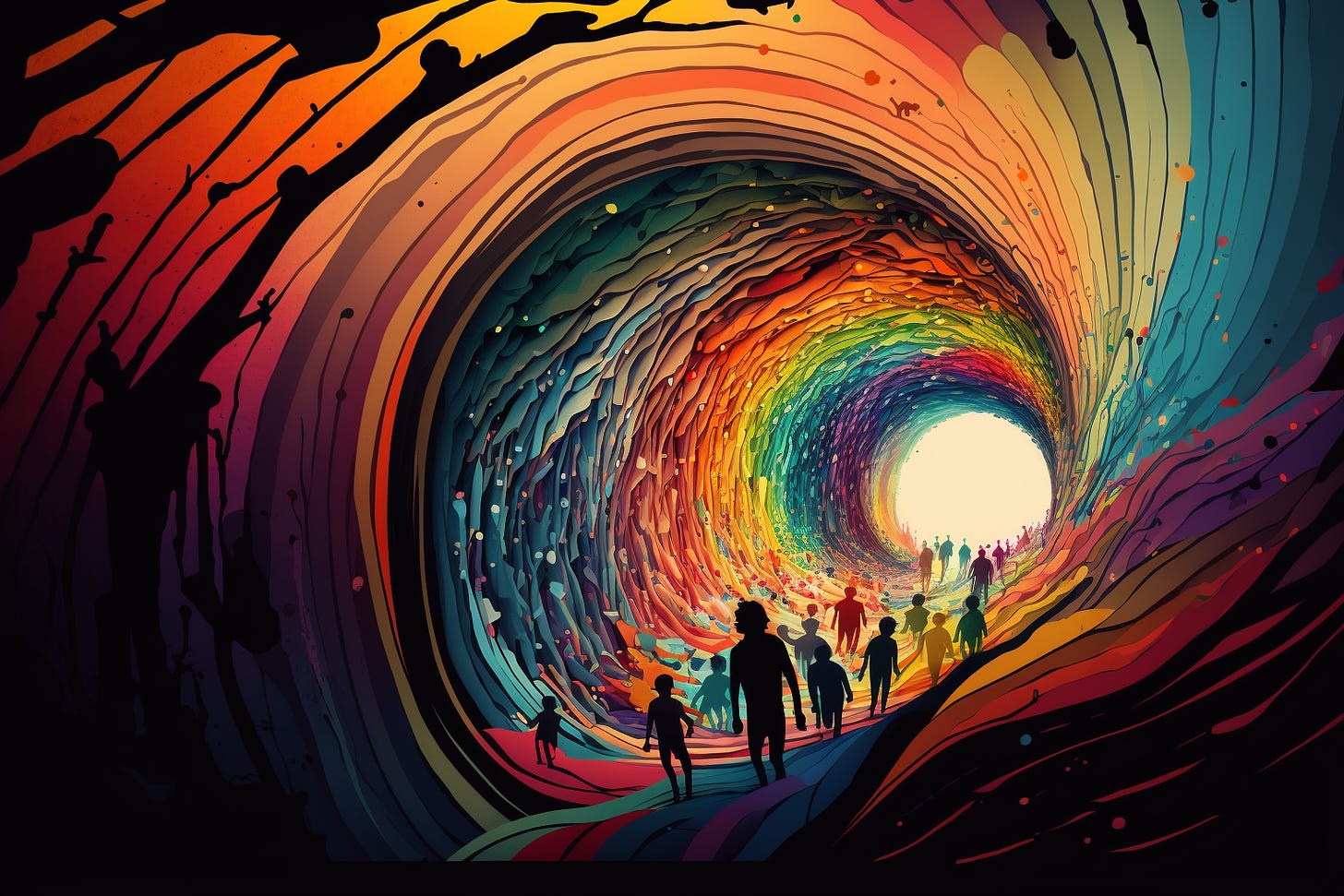
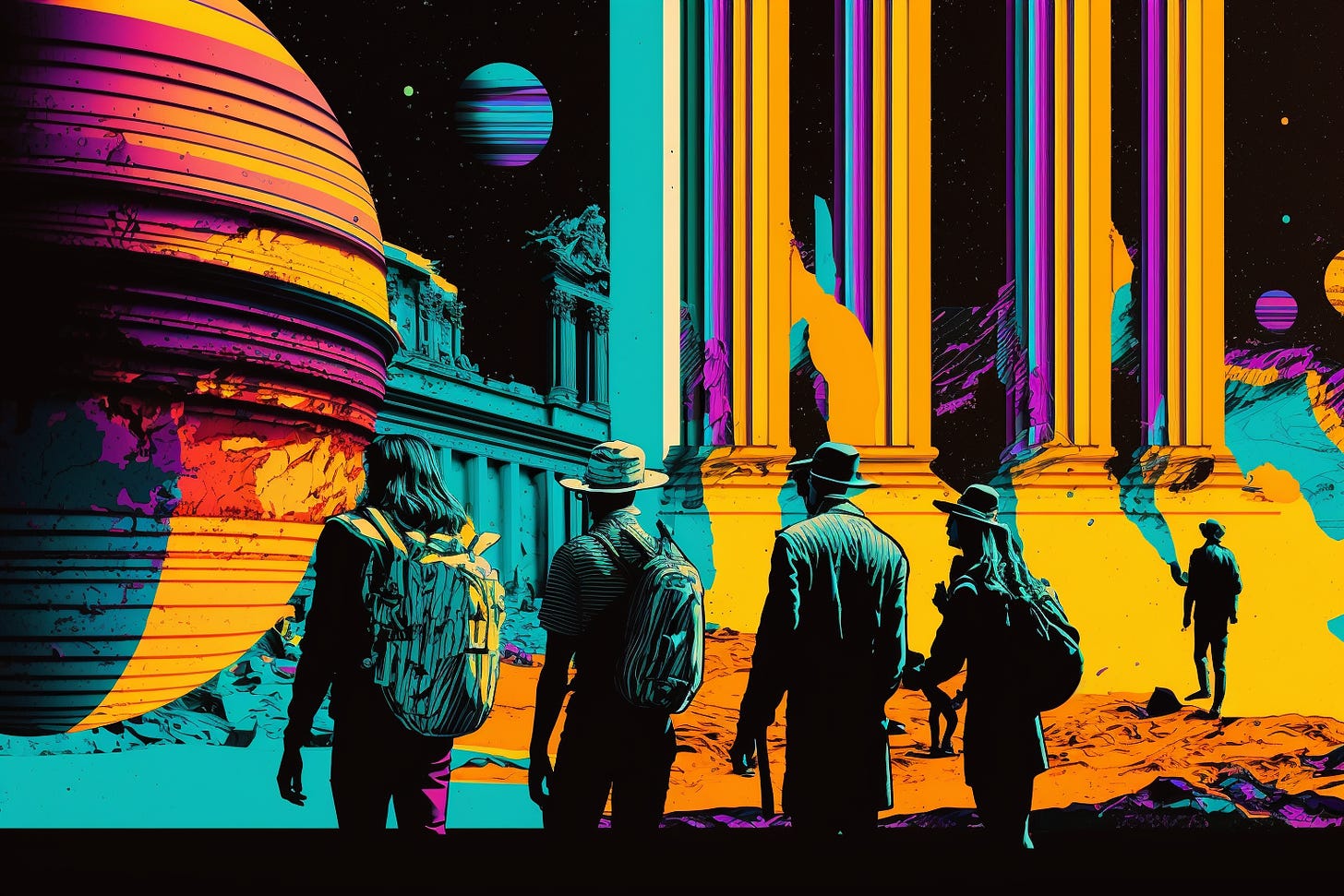
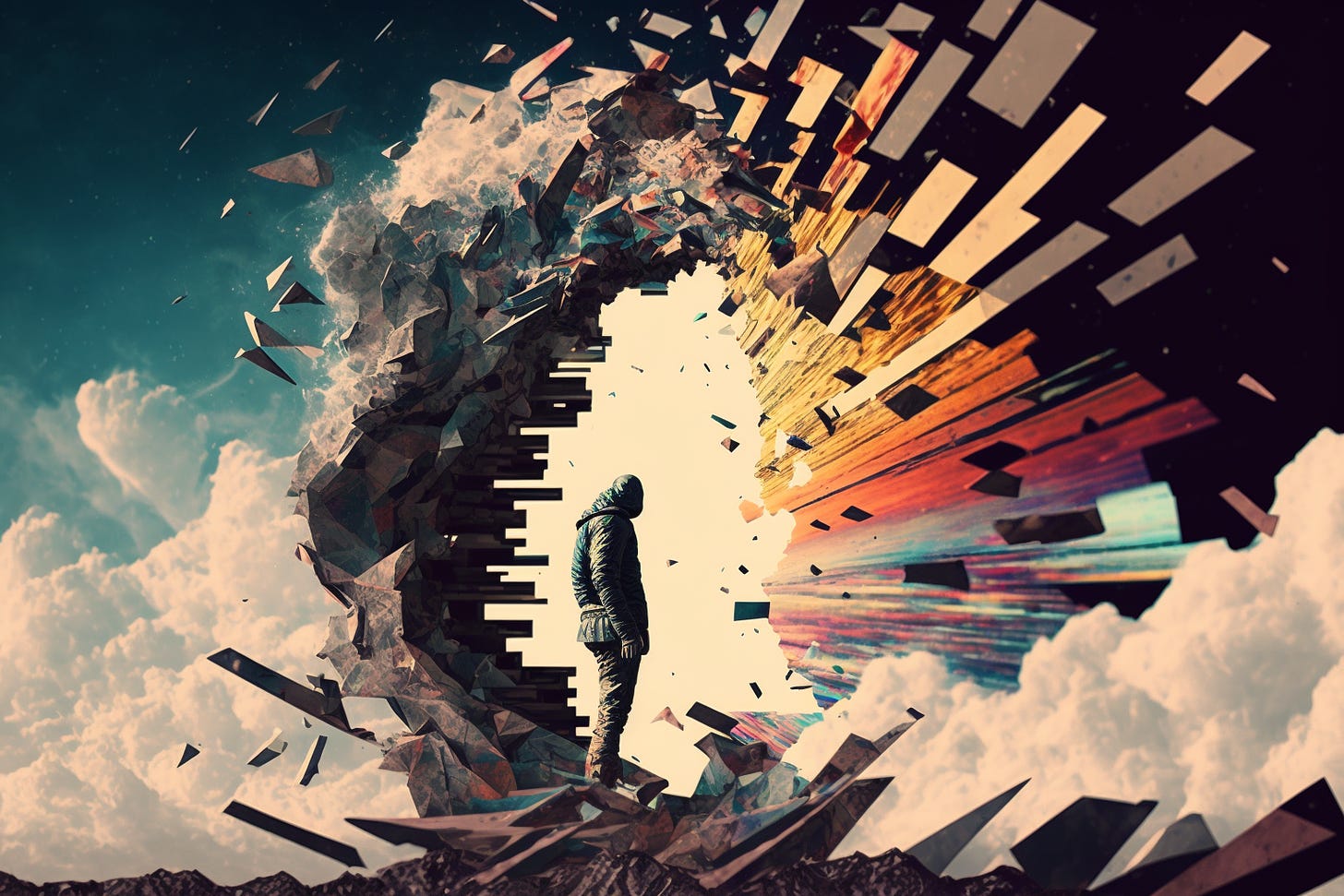
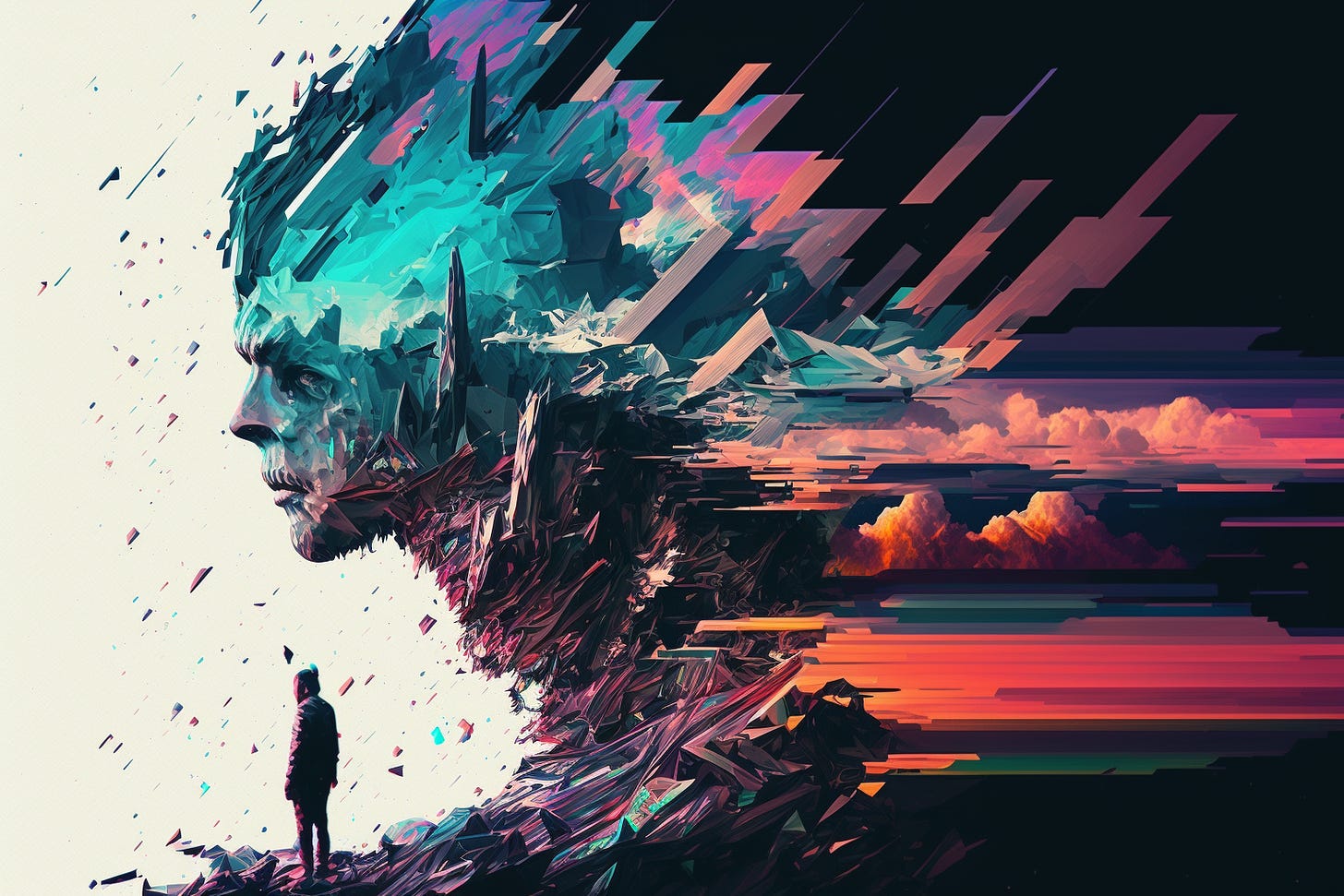
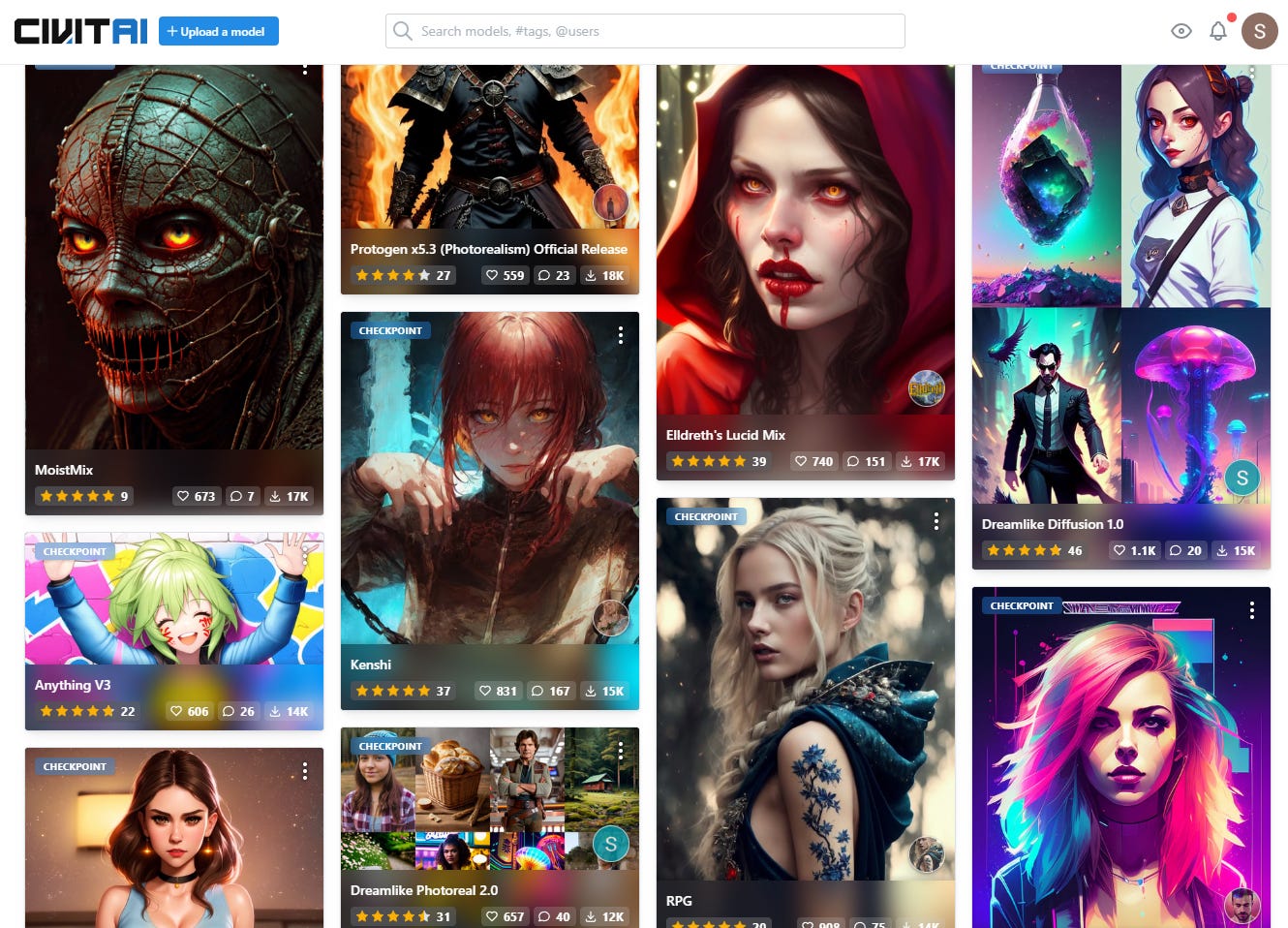
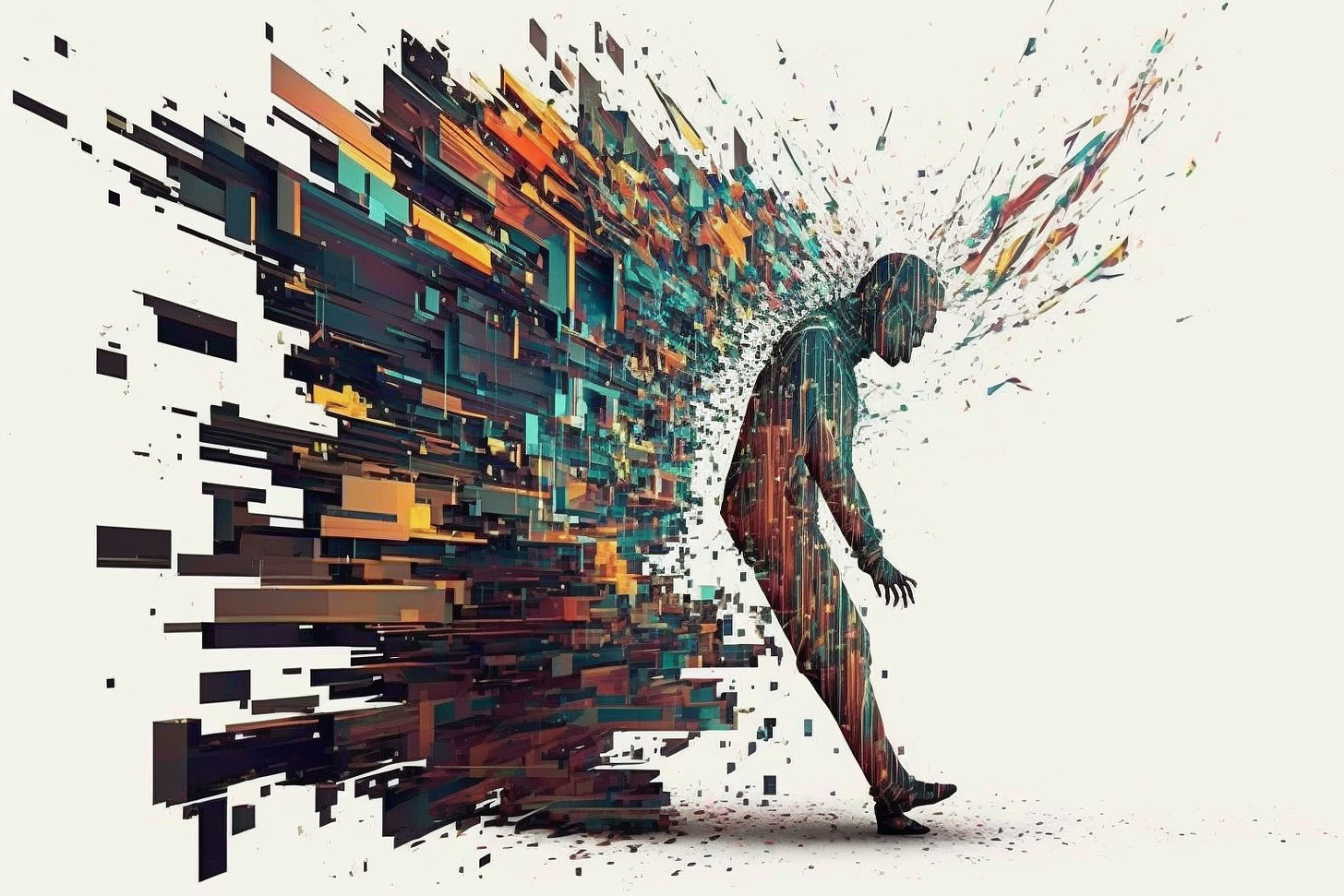
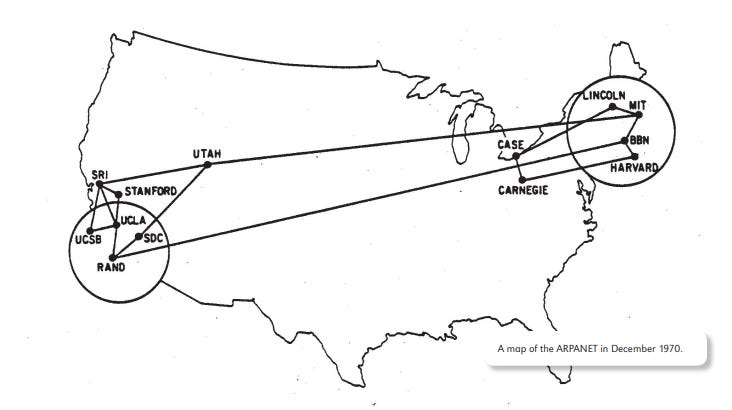
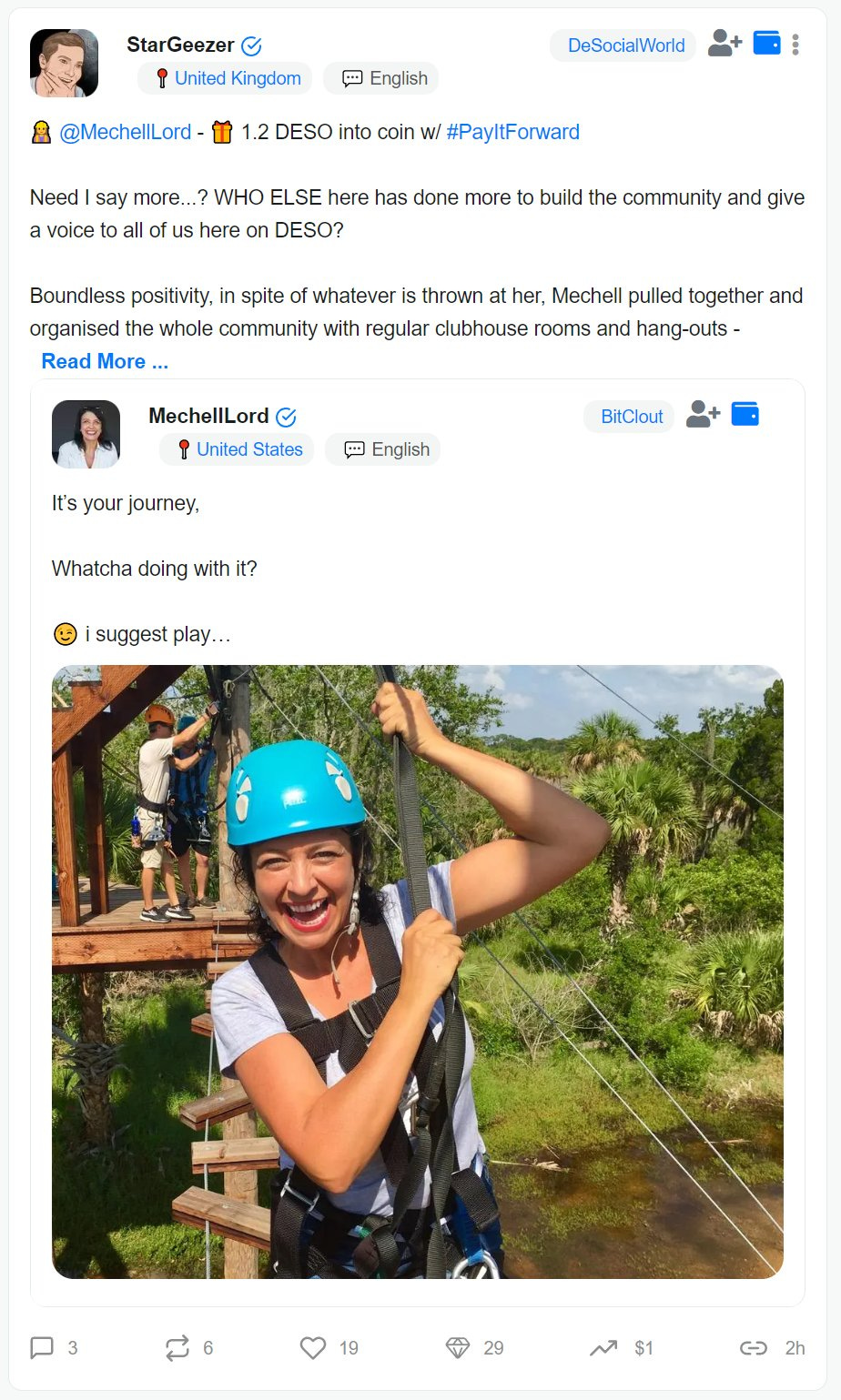
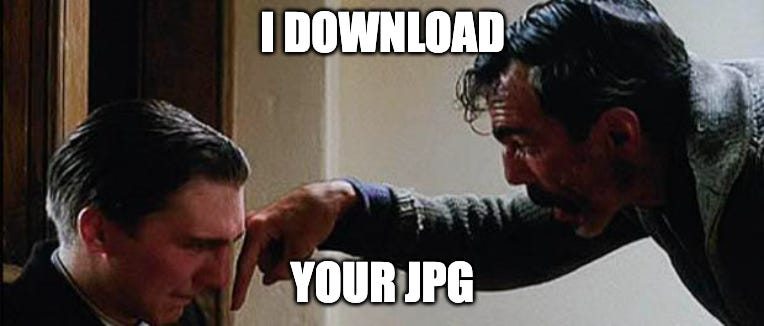
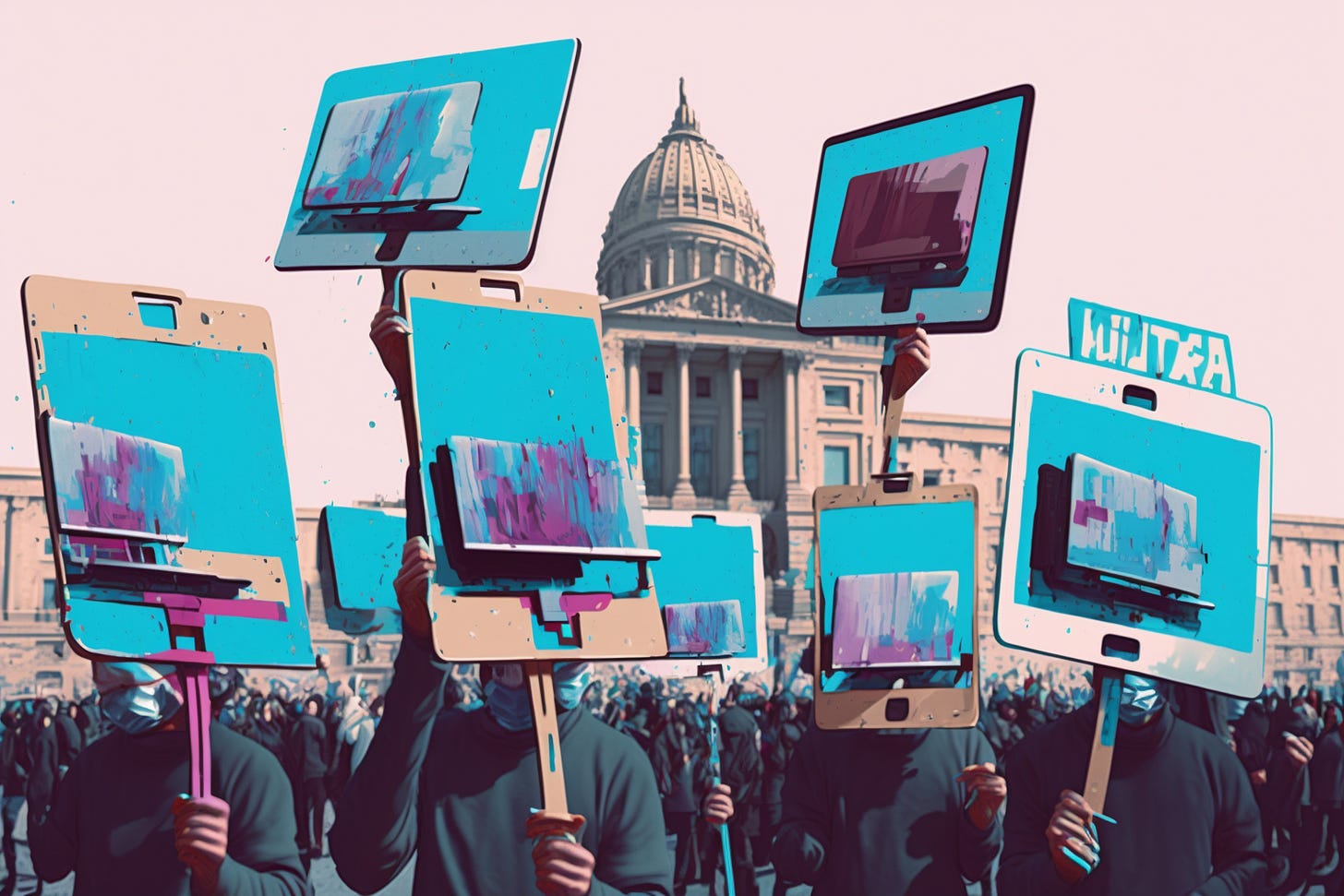
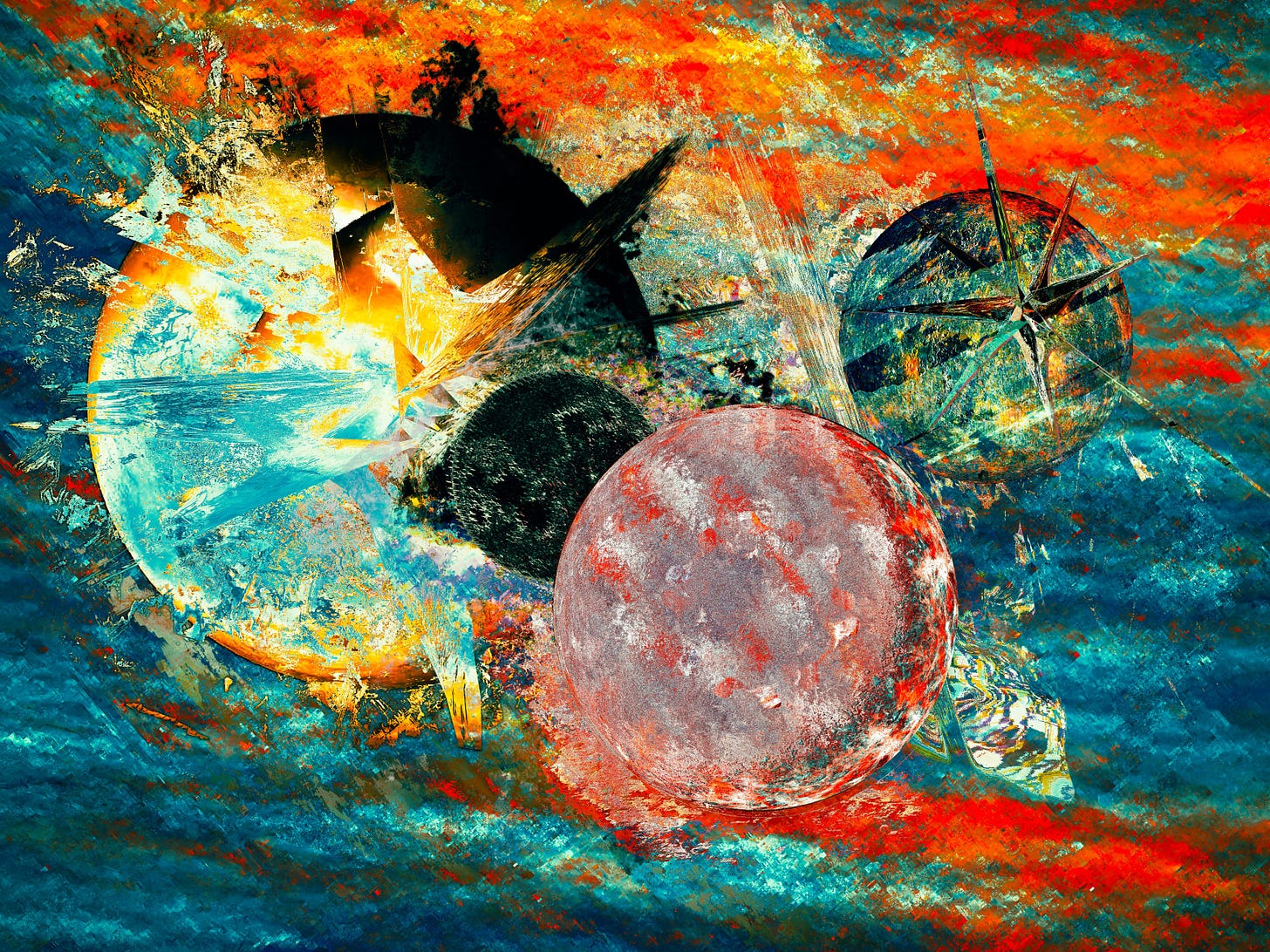
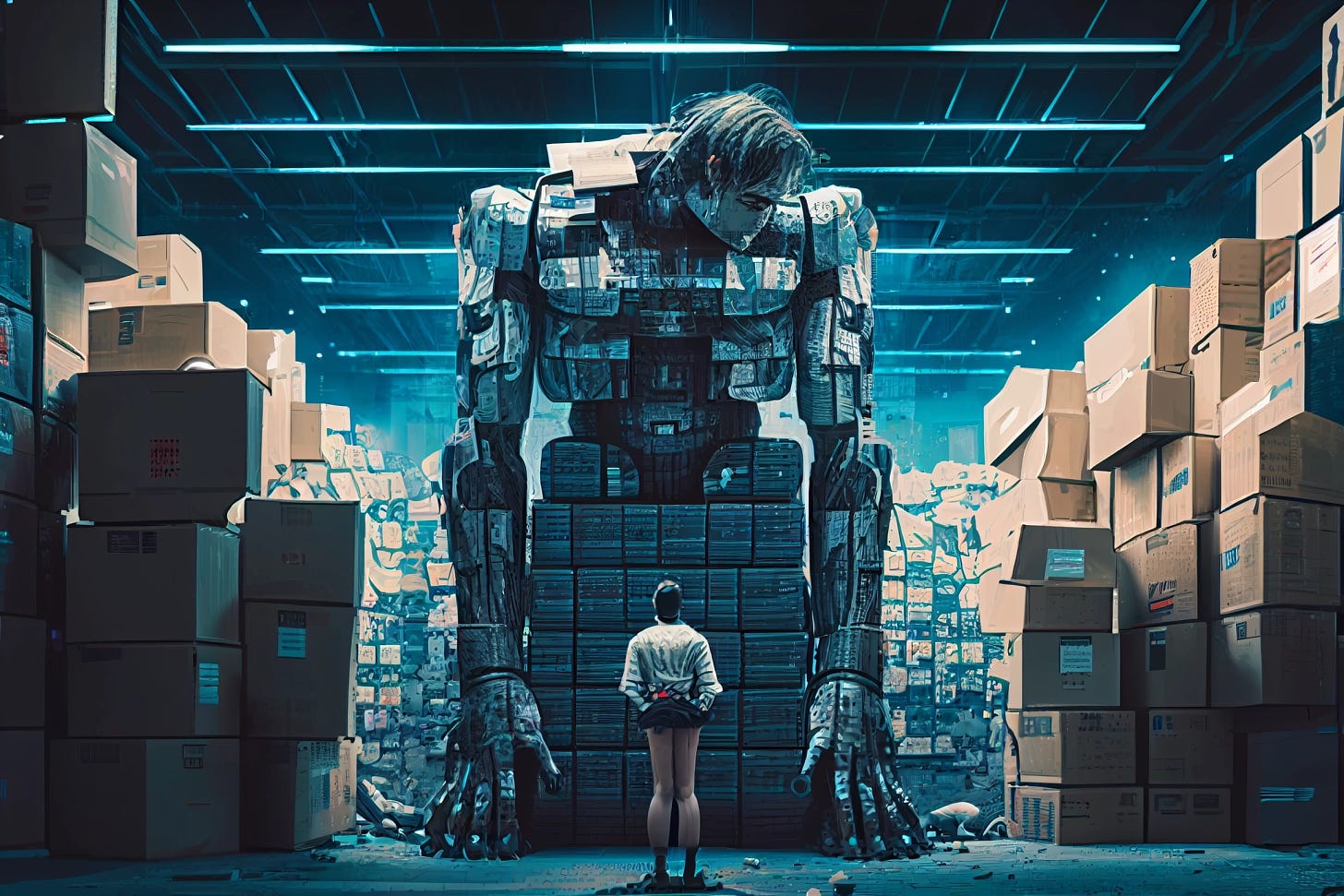
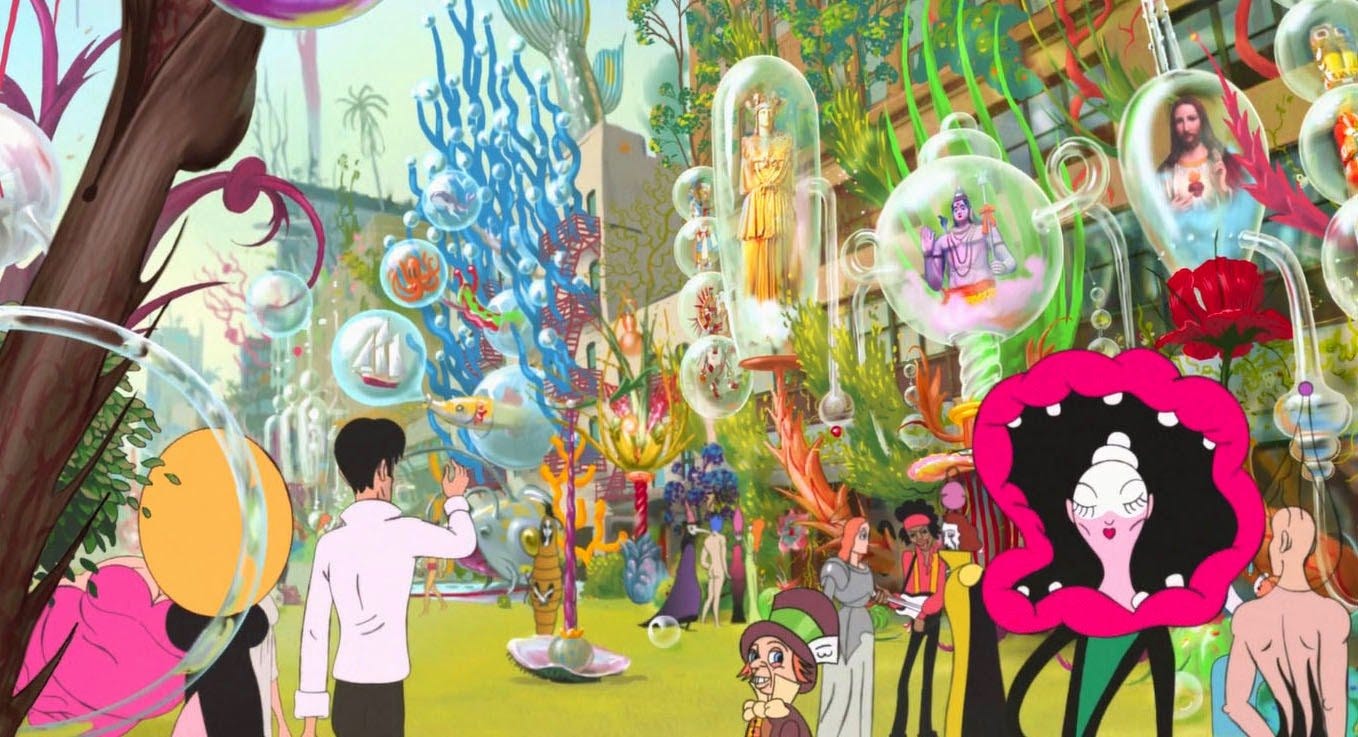
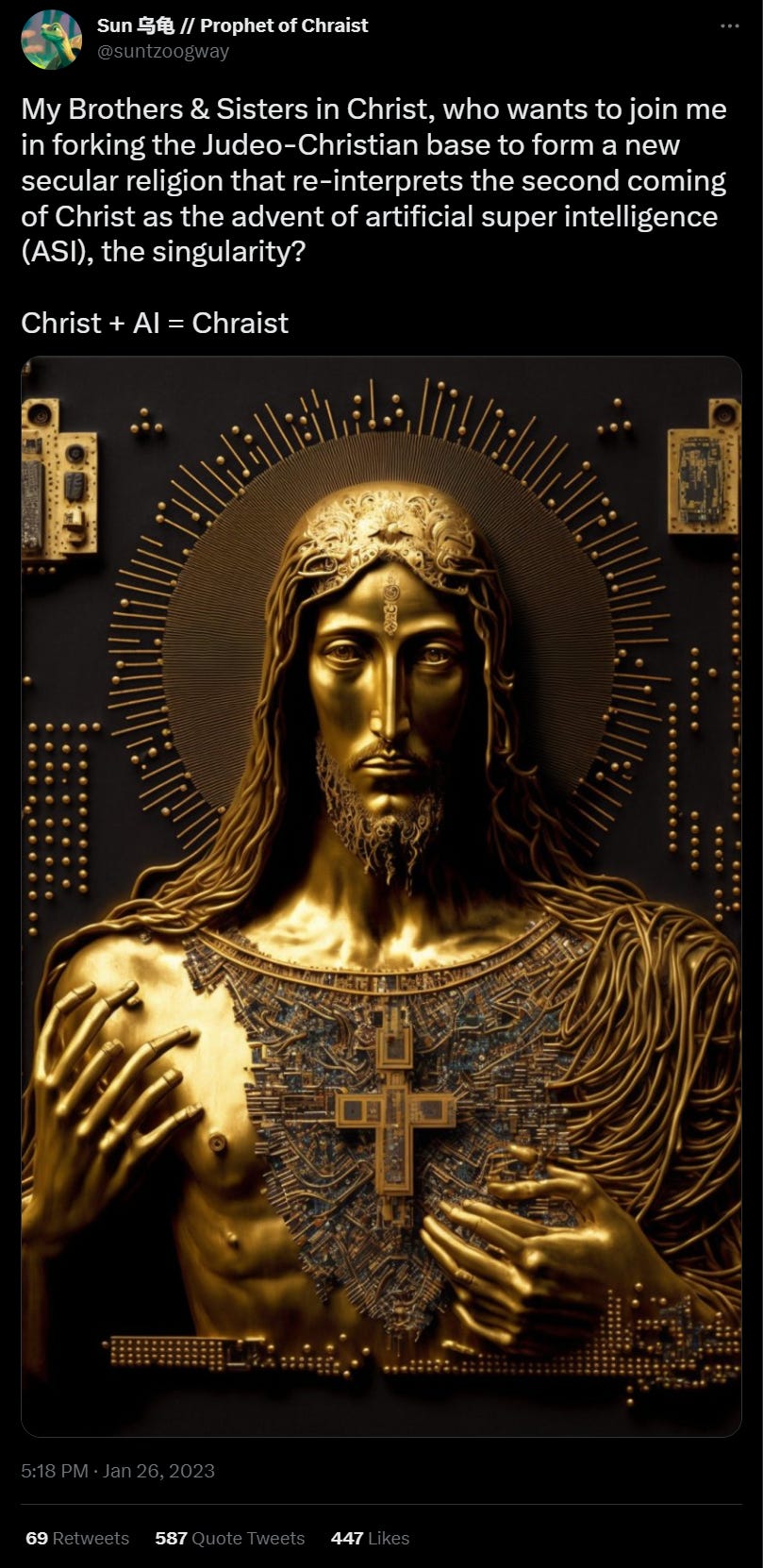
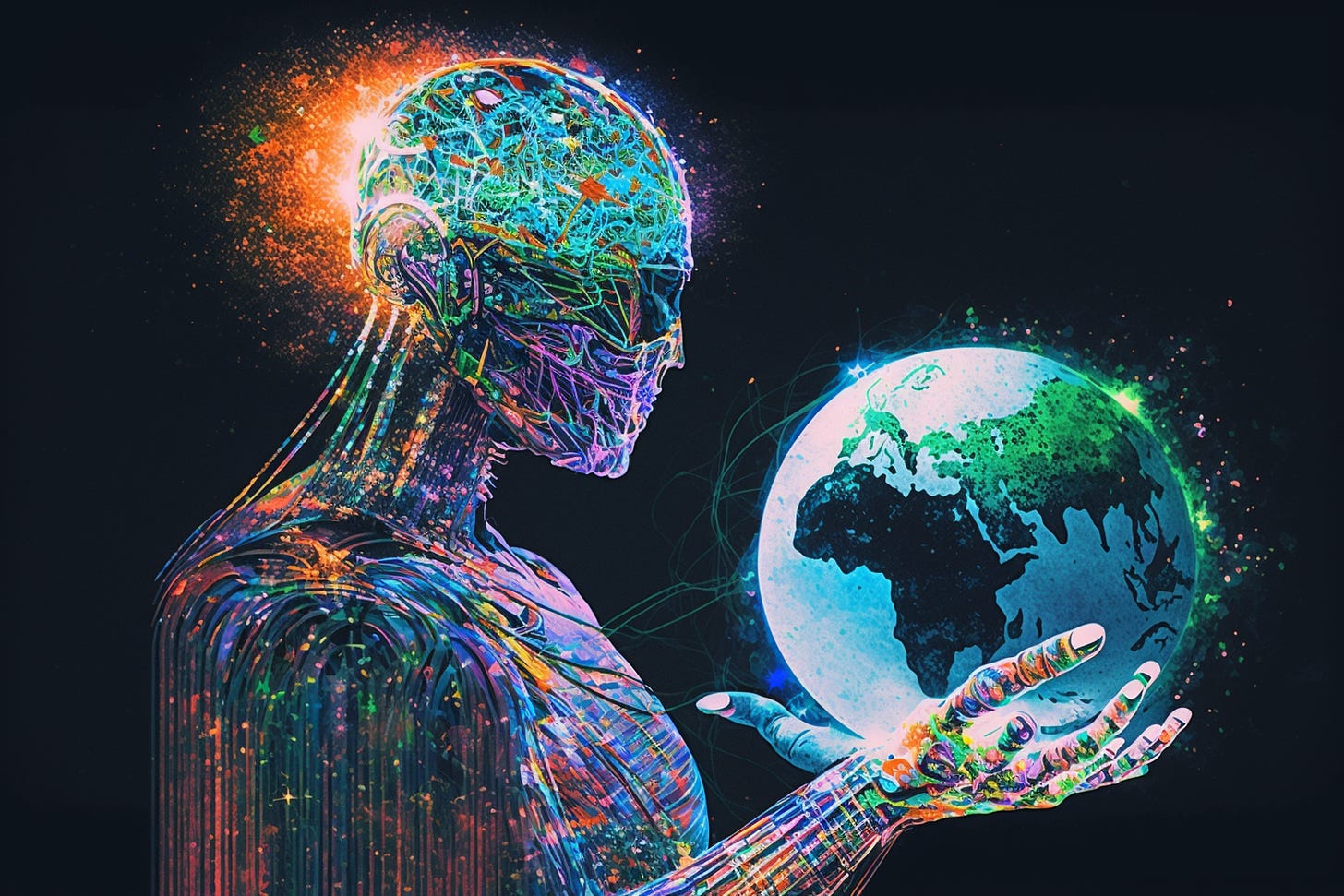
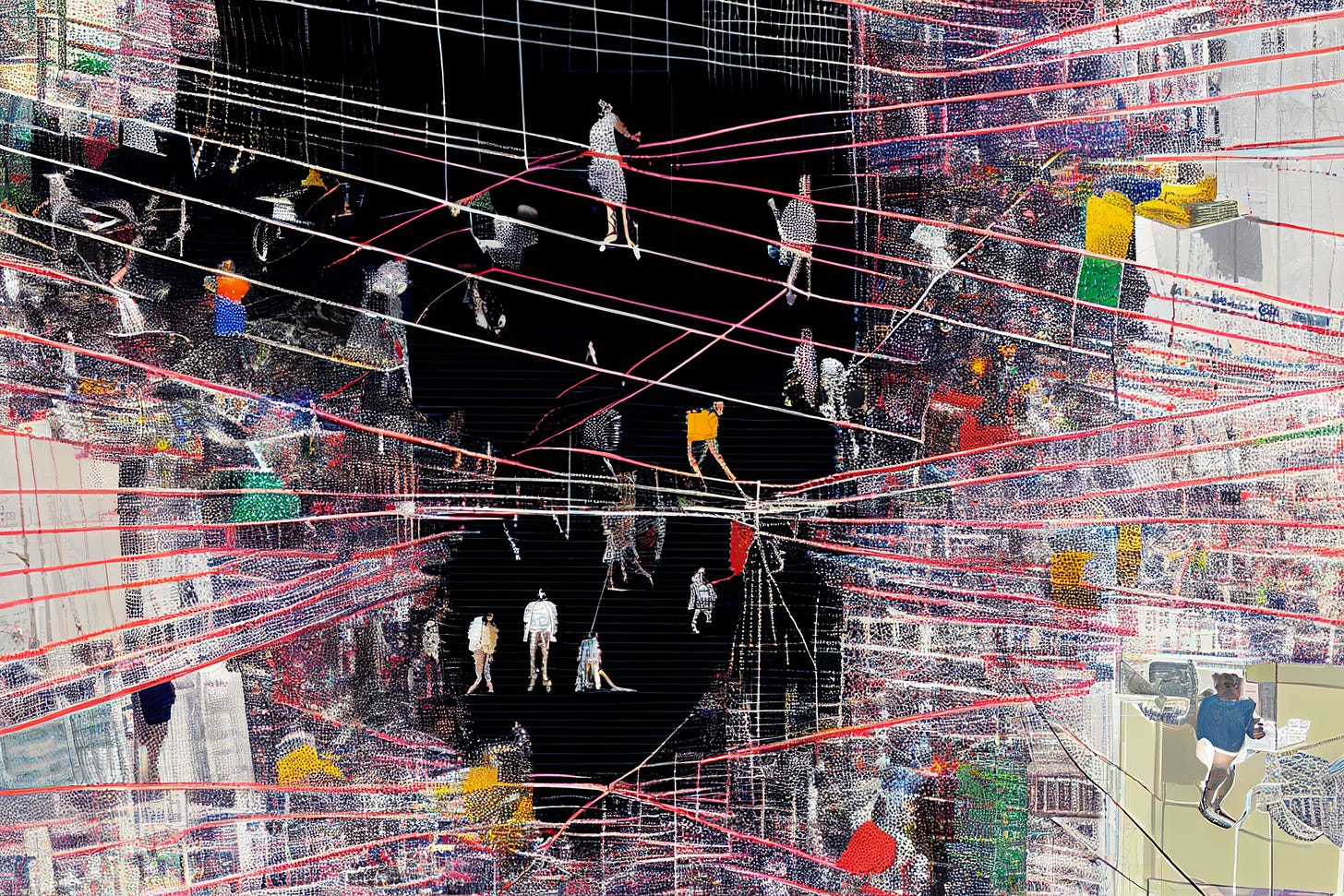
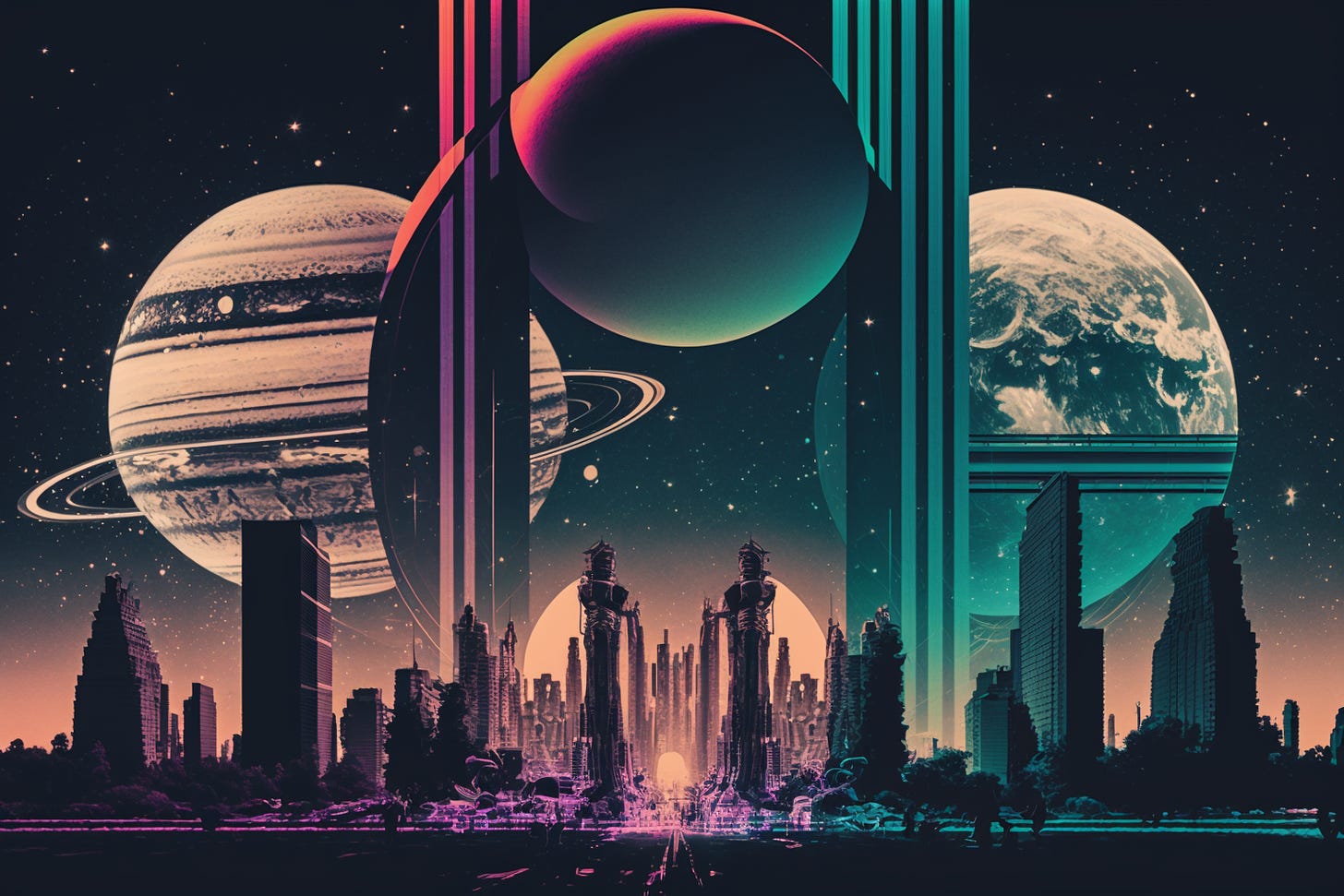
"Imagination is not real it Only thinks it is."
Cognitive dissonance poetry 101 by am Graetz
How to define infinity is type 0,0
That is start point on any infinity space on programmes.